






A Brief Report Focusing on Key Biodiversity Areas
The authors extend their sincere gratitude to the dedicated individuals and departments whose contributions were instrumental in the preparation of this report.
Terrestrial team
Mohamed Darwish, Abdulssalam Khafsha, Ali Alzahrani, André Liz, Bárbara Santos, Duarte Gonçalves, Fulvio Licata, Hugo Rebelo, Leili Khalatbari, Marcello Bilancioni, Margaretta Lakušić, Martina Panisi, Myrto Roumelioti, Raquel Oliveira, Vidak Lakušić, and Yuri Simone.
Reviewers
Khaldoun Alomari, Muhammed Arif, Faisal Alomair, Licia Calabrese Licia Calabrese, and Simon Pearson.
Contributors
Ahmed Alghanmi, Pamela Neubert, Saber Zaki, Abdollah Ayaad, Abdullah Alhamdi, Arwa Al Turki, Khuld Jabby, Bayan Alghamdi, Reem Alshamekh, Mona Siraj, and Lama Altoukhi.
Photos Credits
Khalid Aldahlawi, Ali Alzahrani, Ana Coelho, Diogo F. Ferreira, Duarte Gonçalves, Fulvio Licata, José Carlos Brito, Marcello Bilancioni, Raquel Oliveira, Vidak Lakušić, and Yuri Simone.
This report marks a significant milestone in fulfilling Red Sea Global’s (RSG) commitments under the Saudi Green Initiative (SGI).
This publication was developed through a project “Terrestrial Spatial Habitats Assessment for Biodiversity Conservation in the Red Sea zone,” executed by Department of Environmental Protection & Regeneration, Red Sea zone, Red Sea Global, Saudi Arabia in partnership with BIOPOLIS/CIBIO, Porto University, Portugal.
Citation
El-Bana, M.I., Brito, J.C., Ferreira, D.F., Coelho, A.P., Campos, J., Al-Ansari, A., Al-Attas, O. (2025). Terrestrial baseline assessment of the Red Sea zone: A brief report focusing on key biodiversity areas. Department of Environmental Protection & Regeneration, Red Sea Global, Riyadh, Saudi Arabia.
Authors
Magdy El-Bana1,2
Ahmed Al-Ansari1,3
Omar Al-Attas
José Carlos Brito4,5,6
Diogo F. Ferreira4,5
Ana P. Coelho4,5
João Campos4,5
1. Department of Environmental Protection and Regeneration, Red Sea Global (RSG), Umluj, Saudi Arabia.
2. Department of Botany, Faculty of Science, Port Said University, Egypt.
3. Department of Environment, Faculty of Environmental Sciences, King Abdulaziz University, Saudi Arabia.
4. CIBIO, Centro de Investigação em Biodiversidade e Recursos Genéticos, InBIO Laboratório Associado, Campus de Vairão, Universidade do Porto, Vairão, Portugal.
5. BIOPOLIS Program in Genomics, Biodiversity and Land Planning, CIBIO, Campus de Vairão, Vairão, Portugal.
6. Departamento de Biologia, Faculdade de Ciências, Universidade do Porto, Portugal.







The Red Sea has long been a symbol of natural beauty, biodiversity, and cultural heritage. At Red Sea Global (RSG), we recognize the profound responsibility that comes with developing one of the world’s most extraordinary and ecologically significant regions. Our commitment to regenerative tourism goes beyond conservation—it is about actively restoring and enhancing the ecosystems that make this place so special.
This brief report on the Terrestrial Key Biodiversity Areas (KBAs) of the Red Sea zone marks a significant milestone in our ongoing efforts to protect and enhance the region’s unique natural landscapes and wildlife. Conducted in collaboration with BIOPOLIS/CIBIO from Porto University in Portugal, it stands as the most comprehensive terrestrial baseline survey we've ever conducted. Through rigorous scientific research, we have identified 11 KBAs at the Red Sea zone level—critical habitats that support a remarkable diversity of flora and fauna, including 41 threatened species at the Red Sea zone-level, 88 geographically restricted species within the Red Sea zone region, and 19 species endemic to the Arabian Peninsula.
This report is more than just data—it is a call to action. By analyzing the distribution, population status, and ecological significance of these terrestrial KBAs, we can integrate scientific insights into our development strategies with confidence. This knowledge enables us to designate protected areas, develop effective restoration plans, and implement targeted conservation measures to safeguard the longterm viability of these ecosystems.
At RSG, we are redefining responsible development by setting new benchmarks
in sustainability. Our goal of achieving a 30% Net Conservation Gain by 2040 is ambitious, yet essential. We are not merely minimizing our impact—we are actively creating a positive one.
By aligning with Saudi Vision 2030, the UN Sustainable Development Goals, and the Convention on Biological Diversity (CBD), we are strengthening Saudi Arabia’s position as a global leader in sustainable development and environmental stewardship.
Additionally, our efforts contribute directly to the strategic goals of the Saudi Green Initiative, further advancing the Kingdom’s commitment to a greener, more sustainable future.
This report reaffirms that luxury tourism and environmental preservation can thrive together. By protecting terrestrial biodiversity hotspots, we safeguard ecosystems while ensuring future generations can experience the Red Sea zone’s natural beauty.
This is just the beginning. We are committed to monitoring, restoring, and enhancing these habitats, continuously raising the bar for sustainability.
I invite you to explore this report and join us in redefining tourism one that is regenerative, responsible, and sustainable.

The Red Sea has long been a symbol of natural beauty, biodiversity, and cultural heritage. At Red Sea Global (RSG), we recognize the profound responsibility that comes with developing one of the world’s most extraordinary and ecologically significant regions. Our commitment to regenerative tourism goes beyond conservation—it is about actively restoring and enhancing the ecosystems that make this place so special.
This brief report on the Terrestrial Key Biodiversity Areas (KBAs) of the Red Sea zone marks a significant milestone in our ongoing efforts to protect and enhance the region’s unique natural landscapes and wildlife. Conducted in collaboration with BIOPOLIS/CIBIO from Porto University in Portugal, it stands as the most comprehensive terrestrial baseline survey we've ever conducted. Through rigorous scientific research, we have identified 11 KBAs at the Red Sea zone level—critical habitats that support a remarkable diversity of flora and fauna, including 41 threatened species at the Red Sea zone-level, 88 geographically restricted species within the Red Sea zone region, and 19 species endemic to the Arabian Peninsula.
This report is more than just data—it is a call to action. By analyzing the distribution, population status, and ecological significance of these terrestrial KBAs, we can integrate scientific insights into our development strategies with confidence. This knowledge enables us to designate protected areas, develop effective restoration plans, and implement targeted conservation measures to safeguard the longterm viability of these ecosystems. At RSG, we are redefining responsible development by setting new benchmarks
in sustainability. Our goal of achieving a 30% Net Conservation Gain by 2040 is ambitious, yet essential. We are not merely minimizing our impact—we are actively creating a positive one.
By aligning with Saudi Vision 2030, the UN Sustainable Development Goals, and the Convention on Biological Diversity (CBD), we are strengthening Saudi Arabia’s position as a global leader in sustainable development and environmental stewardship.
Additionally, our efforts contribute directly to the strategic goals of the Saudi Green Initiative, further advancing the Kingdom’s commitment to a greener, more sustainable future.
This report reaffirms that luxury tourism and environmental preservation can thrive together. By protecting terrestrial biodiversity hotspots, we safeguard ecosystems while ensuring future generations can experience the Red Sea zone’s natural beauty.
This is just the beginning. We are committed to monitoring, restoring, and enhancing these habitats, continuously raising the bar for sustainability.
I invite you to explore this report and join us in redefining tourism one that is regenerative, responsible, and sustainable.
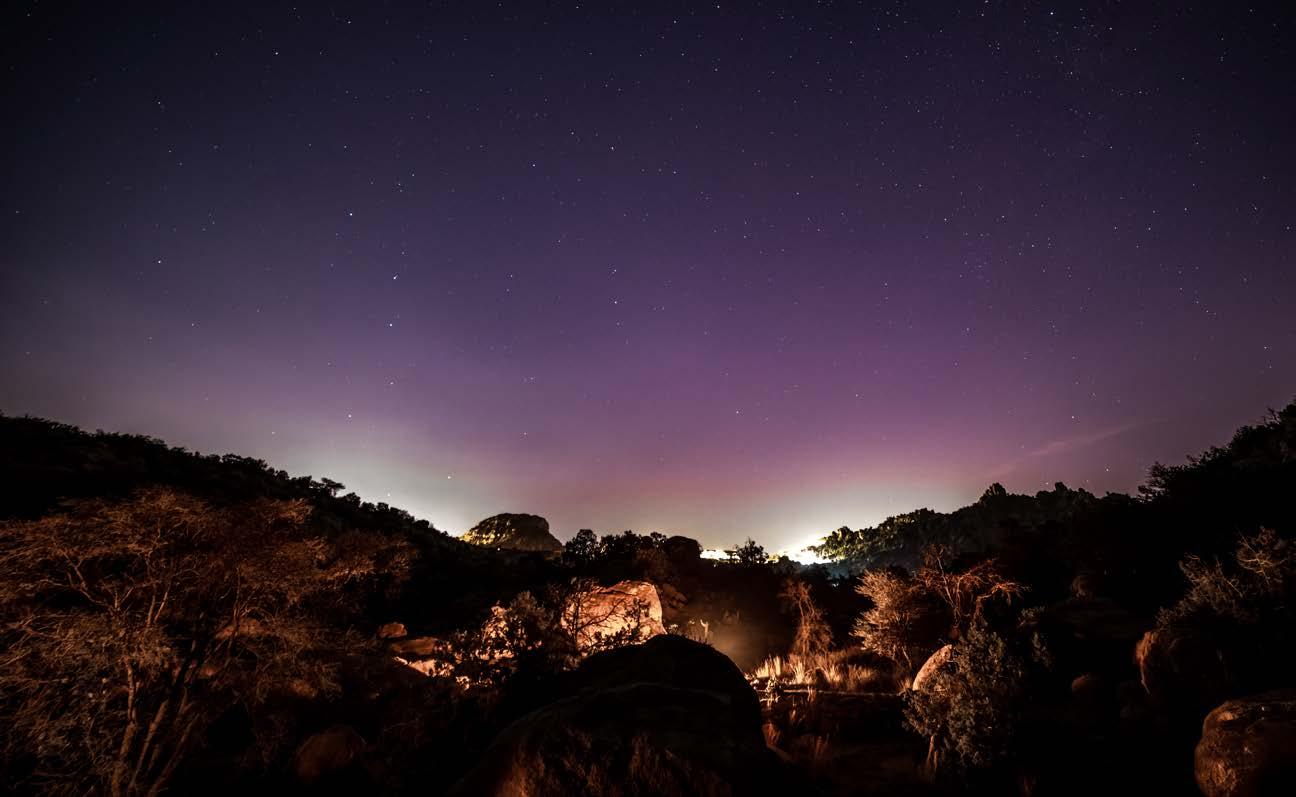

Red Sea Global (RSG) is dedicating a special emphasis to environmental sustainability and long-term biodiversity conservation as essential pillars for regenerative tourism that enhances natural landscape, cultural heritage, and the wellbeing of surrounding communities.
In collaboration with BIOPOLIS, CIBIO, and the University of Porto in Portugal, Red Sea Global (RSG) conducted the first and most comprehensive terrestrial biological survey of The Red Sea and AMAALA destinations, collectively referred to as the Red Sea zone. The initiative, titled Terrestrial Spatial Habitats Assessment for Biodiversity Conservation, aims to achieve the following objectives over a two-year period:
1) Conduct detailed field surveys to build robust baseline data on the flora and fauna of terrestrial habitats within the Red Sea zone, supporting the establishment of Terrestrial Protected Areas.
2) Develop management plans for these protected areas.
3) Create terrestrial biodiversity indicators and a Net Conservation Gain index.
4) Define a comprehensive strategy and
implementation plan for the Terrestrial Ecological Restoration and Enhancement Master Plan.
5) Support RSG in developing nature-based tourism.
6) Increase the knowledge, capacity, and involvement of Red Sea zone-local communities in the conservation of biodiversity and natural resources.
The project outcomes will contribute to RSG’s commitments under the Saudi Green Initiative (SGI) (Figures and II). This report presents a summary of the baseline data, with a focus on evaluating Terrestrial Key Biodiversity Areas (KBAs) across the Red Sea zone in accordance with IUCN criteria.
Field missions carried out in 2024 sampled 120 sites—87 on the mainland and 33 on islands—across the Red Sea zone,
including both the AMAALA and The Red Sea destinations. Habitat mapping was conducted using GIS with a 100 m x 100 m spatial resolution, and all spatial data were generated using a projected coordinate system.
In total, 11 KBAs were identified—eight within The Red Sea and three in AMAALA
These areas encompass the distribution of:
19 species endemic to the Arabian Peninsula
41 threatened species within the Red Sea zone
88 geographically restricted species
18 species that exhibit demographic aggregations
Altogether, 136 species—classified as threatened, geographically restricted, endemic, or demographically aggregated— are represented within these KBAs. This constitutes 24% of the total biodiversity recorded in the Red Sea zone.
By managing these KBAs effectively, RSG will preserve a rich and diverse terrestrial ecosystem within the The Red Sea and AMAALA destinations. This proactive conservation approach not only aligns with global biodiversity targets but also strengthens RSG’s standing as a leader in regenerative tourism and sustainable development.
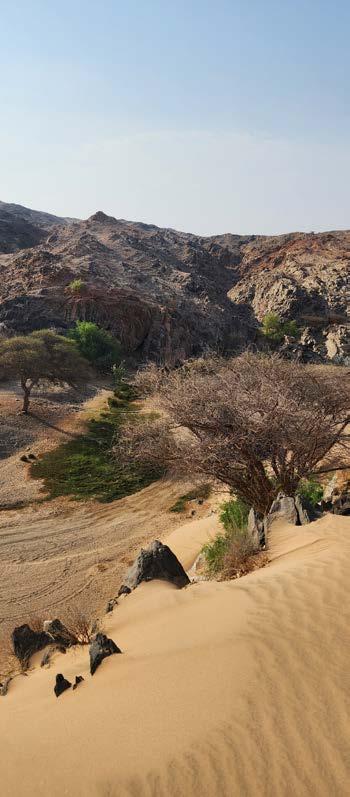
Overview of RSG's contributions to the SGI under the "Protecting Land and Sea" pillar. The diagram highlights key initiatives, including SGI. 2 Terrestrial Biodiversity Baseline Assessment, which focuses on biodiversity conservation, habitat assessment, and species monitoring.
Terrestrial Biodiversity Baseline Assessment under SGI.2 outlining key milestones and deliverables from 2024 to 2025 The pyramid illustration serves as the critical starting point for all subsequent steps. Each ascending layer builds upon the previous one. This sequential framework ensures a comprehensive terrestrial biodiversity strategy.
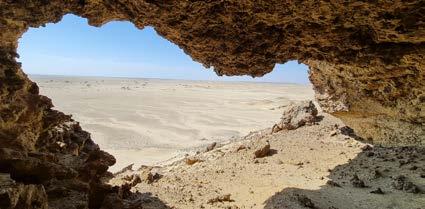
RSG’s portfolio later expanded to include the AMAALA destination. Both The Red Sea and AMAALA are being developed as international luxury destinations with a strong emphasis on environmental sustainability and long-term biodiversity conservation (Figure 01).
RSG’s mission is deeply rooted in Saudi Arabia’s Vision 2030, which positions sustainable development, environmental preservation, and biodiversity protection as key pillars for diversifying and strengthening the Kingdom’s economy. Through the creation of ambitious regenerative tourism destinations that enhance natural landscapes, cultural heritage, and community wellbeing, RSG reinforces the Kingdom’s commitment to long-term environmental and economic sustainability.
This pioneering approach not only sets new international standards but also positions Saudi Arabia as a prominent player on the global tourism map. The Red Sea zone is poised to become a world-class destination for visitors seeking exclusive experiences at the intersection of land and sea. Tourists will be able to explore pristine coastal zones, islands, lagoons, dormant volcanoes, deserts, and mountains, along with unique cultural and ecological features. RSG’s development plans within the Red Sea zone align with the United Nations Sustainable Development Goals (SDGs) and the Convention on Biological Diversity (CBD), placing the company within a global framework focused on halting biodiversity loss, protecting vulnerable species, and restoring ecosystems.
Originally established in 2018 to develop The Red Sea, RSG has since expanded its mission to encompass a broader environmental mandate—safeguarding ecologically valuable habitats, restoring degraded areas, and achieving a minimum of 30% net conservation gain. This directly supports Target 3 of the Kunming-Montreal Global Biodiversity Framework, which calls for the protection of at least 30% of the world’s terrestrial, freshwater, and marine ecosystems by 2030.
RSG’s initiatives also align with the broader goals of the landmark UN Biodiversity Agreement, specifically the 23 targets set at COP15, including ecosystem protection, reducing harmful subsidies, and halving global food waste. Furthermore, RSG supports the Paris Agreement (COP21) and the objectives outlined in Saudi Arabia’s Updated First Nationally Determined Contributions (NDCs), including emissions reduction, climate adaptation, and responsible development.
Despite the exceptional natural features of the Red Sea zone, the region faces significant environmental challenges due to its hot, arid climate and the impacts of human activity and climate change. These include drought, overgrazing, logging, and unregulated land cultivation—all of which have contributed to the degradation of natural ecosystems. In response, a range of strategies has been launched under Vision 2030 to protect, restore, and sustainably manage these fragile environments.
The current initiative, Terrestrial Spatial Habitats Assessment for Biodiversity Conservation, focuses on terrestrial habitats, biodiversity conservation, and management strategies that promote the restoration of natural capital and the sustainable use of resources within the Red Sea zone. It evaluates terrestrial habitats for their conservation value and supports the planning and execution of RSG’s broader environmental strategies to preserve, restore, and enhance the region’s natural and wildlife heritage.
This assessment report presents an unprecedented and robust baseline for terrestrial biodiversity, including KBAs mapping that identifies zones critical to the long-term conservation of species within the Red Sea zone. The resulting data also contributes to the advancement of ecotourism and the economic diversification of local communities.
By aligning with Vision 2030 and the CBD, this initiative reinforces national environmental and economic goals while contributing meaningfully to global conservation efforts. RSG’s commitment to net biodiversity gain strengthens both domestic and international actions aimed at ecosystem protection, restoration, and sustainability—further affirming the company’s credibility and its commitment to both people and the planet.
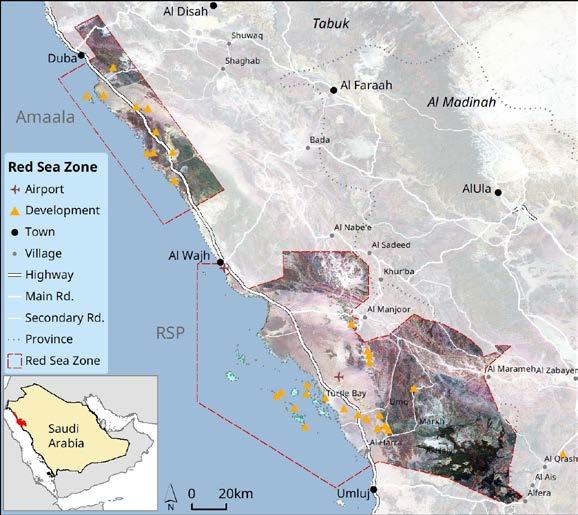
The study areas addressed by current baseline assessment within the Red Sea zone comprise the terrestrial sectors of The Red Sea, totalling 10,620 km2, and AMAALA, totalling 2,567 km2, occupying a total of 13,187 km2 (Figure 01).
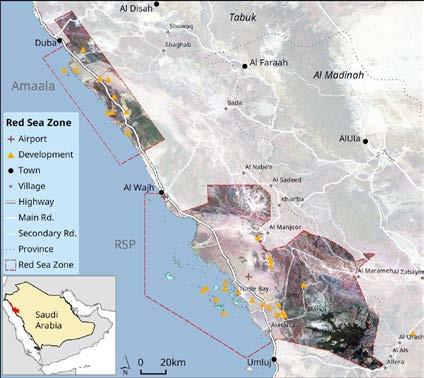


The field sampling scheme was based on preselected sites designed to cover the conservation areas and the environmental variability of the Red Sea zone region. Field sampling of flora and fauna targeted the same general and island sites but occurred at distinct times throughout the year.
The flora inventory was conducted over 41 days, from May 5th to June 24th, 2024. Fauna field sampling was carried out during three separate field missions in 2024:
• M1: 58 days between March 7th and May 3rd 2024, with 7 to 12 fauna experts.
• M2: 35 days between June 1st and July 5th 2024, with 8 to 12 fauna experts.
• M3: 37 days between September 9 th and October 15th 2024, with 10 to 11 fauna experts.
These missions were scheduled to cover a broad range of climatic conditions experienced in the Red Sea zone throughout the year, excluding winter, to ensure sampling during different phenological and activity peaks of the various taxonomic groups under study.
Key Biodiversity Areas (KBAs) are sites that contribute significantly to the global, regional, or local persistence of biodiversity. The identification of KBAs in the Red Sea zone region followed the guidelines set by the IUCN (IUCN 2016; KBA Standards and Appeals Committee 2022). A set of multiple criteria, grouped under five categories, was used to identify KBAs (see Ferreira et al., 2024), with at least one criterion required for a site to qualify as a KBA:
A) Threatened biodiversity
This criterion identifies sites that contribute significantly to the regional persistence of locally threatened species (A1) or threatened ecosystem types (A2), based on IUCN criteria. Conservation status was calculated specifically for the Red Sea zone area, i.e., at the local-Red Sea zone level (see Ferreira et al., 2024).
B) Geographically restricted biodiversity
This criterion identifies sites that contribute significantly to the regional persistence of locally geographically restricted species (B1), co-occurring geographically restricted species (B2), geographically restricted assemblages (B3), or geographically restricted ecosystem types (B4). Species ranges were calculated specifically for the Red Sea zone area, i.e., at the local-Red Sea zone level (see Ferreira et al., 2024).
C) Ecological integrity
This criterion identifies sites that contribute significantly to the regional persistence of wholly intact ecological communities with supporting large-scale ecological processes, essentially unaffected by major human activities.
D) Biological processes
This criterion identifies sites that contribute significantly to the regional persistence of demographic aggregations (D1), ecological refugia (D2 ),
or recruitment sources (D3), essentially where sites hold a significant proportion of a species’ population during at least one of its life stages, making it critical for long-term survival.
E) Irreplaceability
This criterion identifies sites that have very high irreplaceability for the regional persistence of biodiversity, as determined through a complementaritybased quantitative analysis of irreplaceability.
The application of these criteria to identify KBAs was based on multiple indicators (Table 01), including the diversity, rarity, naturalness, uniqueness, and vulnerability of habitats and species, the population sizes of key species (e.g., threatened species for the Red Sea zone area or KSA endemics), and the potential value for restoration and enhancement. Not all criteria could be applied, such as E) Irreplaceability, or sub-criteria like B3) Geographically restricted assemblages, due to a lack of data on species or habitats. When applicable, analyses were conducted in a GIS with a 100 m x 100 m spatial resolution, and all spatial data were produced using the projected coordinate system WGS 1984 UTM Zone 37N.
Table 01 Categories, criteria, and indicators used to identify and map Key Biodiversity Areas in the Red Sea zone region. Keywords: L= Local-Red Sea zone level, R= Regional level, G= Global level. See Ferreira et al. (2024) for more details.
Categories Criteria
Indicator
A) Threatened biodiversity A1 Threatened speciesL Occurrence of threatened flora and fauna
B) Geographically restricted biodiversity
A2 Threatened ecosystem typesG Occurrence of mangroves
B1 Individual geographically restricted species Occurrence of geographically restricted flora and fauna
B2 Cooccurring geographically restricted speciesR Hotspots of flora and fauna endemic to the Arabian Peninsula
B3 Geographically restricted assemblages Not used
B4. Geographically restricted ecosystem typesL Occurrence of wetlands
C) Ecological integrity C. Ecological integrity Occurrence of last of the wild
D) Biological processes D1 Demographic aggregations Occurrence of bird aggregations
D2. Ecological refugiaL Occurrence of wetlands Occurrence of bat roosts
D3. Recruitment sources Occurrence of wetlands
E) Irreplaceability
E. Irreplaceability through quantitative analysis Not used
During the fieldwork missions to the Red Sea zone region in 2024, a total of 120 sites were sampled, comprising 89 sites sampled for both flora and fauna (75%), 10 sites sampled for flora only (8%), and 21 sites sampled for fauna only (17%). From the 120 sites sampled, 87 sites were sampled in mainland areas (72 sites for flora and fauna, 7 site for flora only, and 8 sites for fauna only), and 33 sites were sampled in Islands (17 sites for flora and fauna, 1 site for flora only, and 13 sites for fauna only).
Concerning the sampling of flora, a total of 99 sites were sampled, while for fauna, a total of 110 sites were sampled. In addition, 181 Adhoc sites were sampled for fauna only. The distribution of sampling sites covered the full area of the Red Sea zone region, including The Red Sea and AMAALA destinationsectors, providing a suitable sampling of the environmental variation of the Red Sea zone region (Figure 02)




A total of 11 KBAs were identified in the Red Sea zone region, following the guidelines set by IUCN when applied to the local-Red Sea zone scale (see list of proposed KBAs and their fact sheets). The distribution of the 11 KBAs and their characteristics are displayed in Figure 03 and Table 02, and detailed fact sheet about each KBA is given.
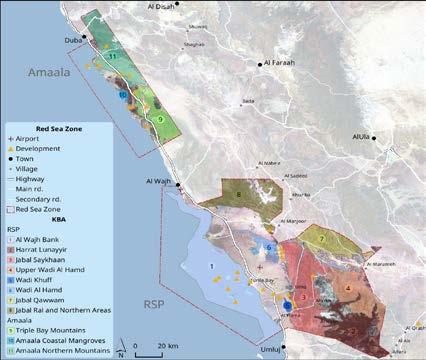
A
Threatened speciesL
Table 02 | List of the 11 KBAs identified in the Red Sea zone and their main characteristics according to the classification criteria. Keywords: WB =Wajh Bank, HL= Harrat Lunayyir, JS=Jabal Saykhaan, UWH=Upper Wadi Al Hamd, WK=Wadi Khuff, WH=Wadi Al Hamd, JQ=Jabal Qawwam, JR=Jabal Ral, ACM=AMAALA Coastal Mangroves, TBM= Triple Bay Mountains, ANM=AMAALA Northern Mountains, M&T= Marine and terrestrial, L= Local-Red Sea zone level, R= Regional level, G= Global level.
A2 Threatened ecosystem typesG
Criterion B
B1 Individual geographically restricted species
B2 Cooccurring geographically restricted speciesR
B4 Geographically restricted ecosystem types
Criterion C
C. Ecological integrity
Criterion D
D Demographic aggregations
N species with demographic aggregations 18
D2 Ecological refugiaL
Occurrence of bat roosts 1 high priority and 2 low
D3 Recruitment sources
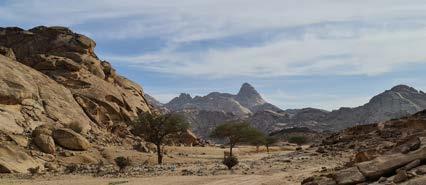
The vast majority of the KBAs were identified using Criteria A1 (threatened species), B1 (geographically restricted species), and B2 (endemic species). Only in The Red Sea – Al Wajh Bank was it possible to also apply Criterion D1 (demographic aggregations). The marine/ terrestrial KBA of Al Wajh Bank and AMAALA Coastal Mangroves displayed considerable representation of the threatened ecosystem type – Mangroves, triggering Criterion A2. Three KBAs featured bat roosts functioning as ecological refugia, triggering Criterion D2. The KBAs of The Red Sea – Harrat Lunayyir and AMAALA – Triple Bay Mountains are particularly important in this regard. Additionally, a considerable area of wetlands was identified in three KBAs, triggering Criteria B4 (geographically restricted ecosystem types), D2, and D3 (recruitment sources), with The Red Sea –Wadi Khuff, The Red Sea – Wadi Al Hamd, and AMAALA – Triple Bay Mountains being of particular significance.
In total, these 11 KBAs cover the distribution of:
• 41 threatened species (Criterion A1),
• 88 geographically restricted species (Criterion B1),
• 19 species endemic to the Arabian Peninsula (Criterion B2),
• 18 species displaying demographic aggregations within the Red Sea zone region (Criterion D1) (Table 03).
A total of 136 species of flora and fauna, classified as threatened, geographically restricted, endemic, or exhibiting demographic aggregations, are represented in the 11 KBAs. This accounts for 24% of the total species diversity identified in the Red Sea zone region (Table 03).
The least represented group was reptiles, with only 15.2% of their species diversity covered in the KBAs. This was due to the relatively few reptile species classified as threatened, geographically restricted, or endemic to the Arabian Peninsula, compared to other taxonomic groups. Birds were also less represented, with 19.1% coverage of their total diversity. This is attributed to the fact that wintering birds were not evaluated against IUCN Red List criteria during the assessment of extinction risk due to a lack of data for the winter period.
In contrast, liverwort plants, amphibians, and fish were 100% covered. On average, 49.7% of the diversity of all taxonomic groups was represented in the identified KBAs.
Table 03 Number of species of flora and fauna included in the 11 KBAs identified in the Red Sea zone by taxonomic group according to the classification criteria and the total number of species covered and the percentage (%) in relation to the total number of species identified in the region.: L= Local-Red Sea zone level, R= Regional level. See
Taxonomic Group
The supervised classification produced a landuse/landcover (LULC) map with 11 classes (Figures 04 and 05), representing the major landscape features present in the Red Sea zone region: volcanic rock, rock outcrops, limestone, sandstone, stony flatlands, sand and gravel flatlands, sandy flatlands, dunes, oasis and vegetated wadis, other perennial vegetation, sparse woodlands, mangroves closed-canopy,
mangroves opencanopy, salt pans, water, and built-up. The final classification presents classes with a high level of identification detail, such as the categories of volcanic rock, sandy LULC types (dunes and sandy flatlands), rock outcrops, and stony flatlands.Each KBA contained a different set of habitats, with KBAs containing between 8 to 13 different habitats (Table 04).
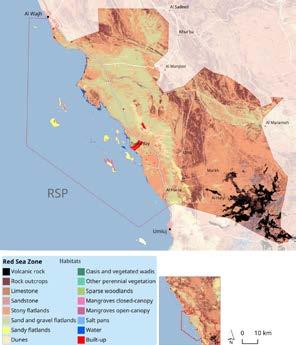
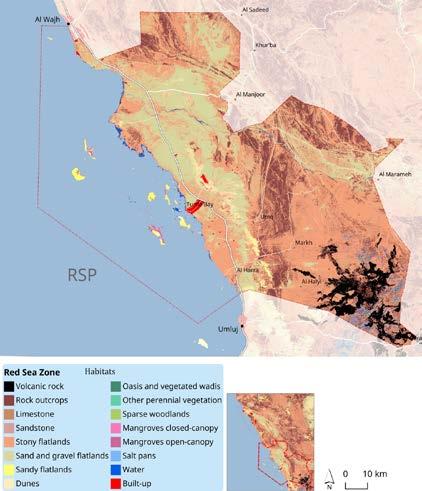
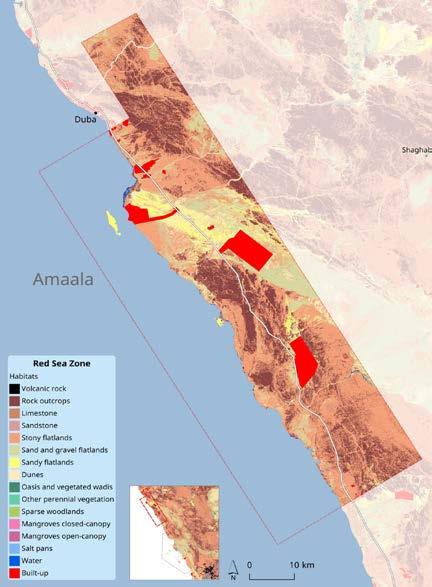
Table 04 | Percentage (%) of each landuse/landcover (LULC) class in each KBA. Keywords:
WB =Al Wajh Bank, HL= Harrat Lunayyir, JS=Jabal Saykhaan, UWH=Upper Wadi Al Hamd, WK=Wadi Khuff, WH=Wadi Al Hamd, JQ=Jabal Qawwam, JR=Jabal Ral and Northern, TBM= Triple Bay Mountains, ANM=AMAALA Northern Mountains, ACM=AMAALA Coastal Mangroves.
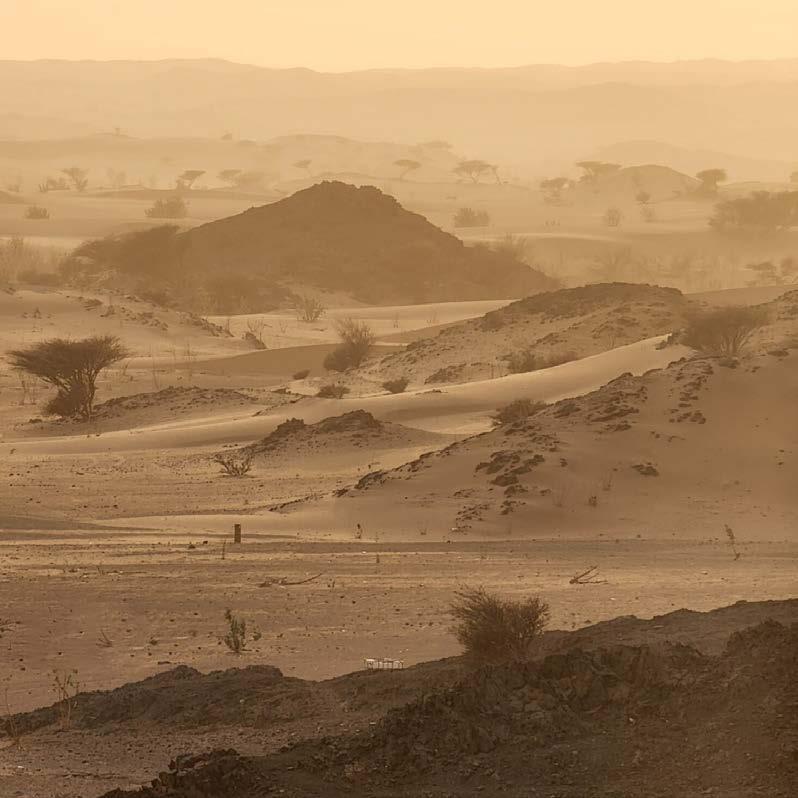


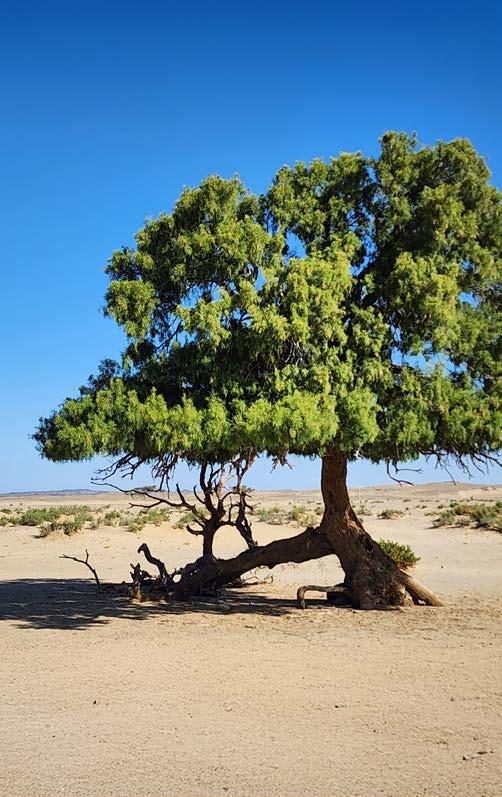
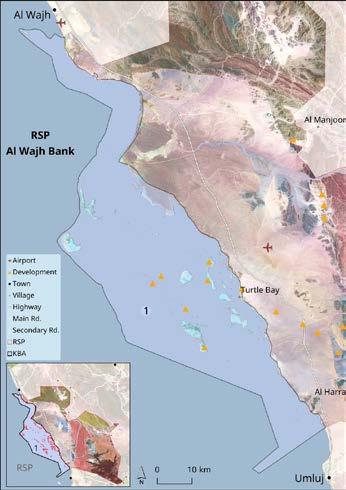

Marine, Terrestrial - 2 to 12
2,835


GLOBAL KBA STATUS

Terrestrial
GLOBAL KBA CRITERIA SYSTEM ELEVATION
2 to 12
2,835
RATIONALE FOR QUALIFYING AS KBA
The Red Sea destination's Al Wajh Bank was classified due to its significance for the conservation of biodiversity. This area supports three species of flora and 21 species of fauna that are of conservation concern and includes a limited area of threatened mangrove (0.5% of the KBA). Significant species of flora include Atriplex farinosa and Rhizophora mucronata, both classified as Vulnerable in the Red Sea zone region. Significant species of fauna include Goliath Heron, Purple Heron, Crab Plover, Red-billed Tropicbird, Eurasian Spoonbill, and Saunders’s Tern, all classified as Endangered in the Red Sea zone region.
Al Wajh Bank was classified as an Important Bird Area (IBA) and as a global KBA in 1994 due to its significance for breeding populations of key bird species. This area is estimated to support approximately 2% of the global population of Sooty Falcon (Calabrese 2022), as well as critical proportions of other priority marine bird species, including: Crab Plover with an estimated 5% of the global population; Sooty Gull with 17%–35%; Pallas’s Gull with 15%; Bridled Tern with 1%; Whitecheeked Tern with 4%; and Lesser Crested Tern with 2% (Calabrese et al. 2024).
However, gaps remain in data on additional bird species that might rely on the archipelago during various stages of their life cycles, which limits the current understanding of how crucial these islands are for the longterm survival of those species. Despite its recognised status as a KBA, its location within a major migratory flyway and the presence of globally and locally threatened species, Al Wajh Bank has been identified as having low value for wintering waterbirds (shorebirds and ducks; Key Biodiversity Areas Partnership 2025). However, due to the lack of studies the importance of these islands as stopover and wintering periods, critical stages in these species’ life cycles, remains underexplored and limits the current understanding of how crucial the KBA is for species aggregations. These birds are experiencing rapid population declines and many species are classified as threatened under the IUCN Red List Data. Despite the several existing knowledge gaps, recent work conducted on the islands by RSG (Calabrese 2022; Calabrese et al, 2024), as well as data collected by BIOPOLIS/ BIODESERTS in the scope of the “Spatial Habitats Assessment for Biodiversity Conservation” project have provided new insights that would allow the updating of this globally important KBA, and the establishment of a local-Red Sea zone KBA.
This site qualifies as a KBA of local-Red Sea zone significance that meets several thresholds for the identification of KBA, namely: Criterion A1 (six EN and eight VU species), A2 (considerable area covered by a threatened ecosystem Mangroves), B1 (eight geographically restricted species), B2 (three endemic species); D1a (holds 18
species with a significant proportion of the population size during one or more key stages of its life cycle).
Crit. A2 Mangroves (km2): 14.67
Table 05 Biodiversity elements triggering KBA criteria. Keywords: T= threatened, GR= geographically restricted, E= endemic, DA= Demographic aggregations, L= Local-Red Sea zone level, R= Regional level. See Ferreira et al. (2024) for more details.
Group Species Crit. A Crit. B1 Crit. B2 Crit. D1a TL
Vascular plants Atriplex farinosa VU
Cyperus conglomeratus Yes
Rhizophora mucronata VU
Mammals Cheesman’s Gerbil Yes
Birds Goliath Heron EN ›90% of the local popula-tion breeds in the area
Purple Heron EN
Ruddy Turnstone
Pharaoh Eagle-owl VU
Green-backed Heron VU
Sanderling
Dunlin
Curlew Sandpiper
Little Stint
Common Ringed Plover
Greater Sand Plover
Siberian Sand Plover
Arabian Sunbird Yes
Crab Plover EN
Black-crowned Sparrow-lark VU Yes
Sooty Falcon VU
Eurasian Oystercatcher
Slender-billed Gull
›90% of local-Red Sea zone nonbreeding pop. in the area
›90% of local-Red Sea zone nonbreeding pop. in the area
›90% of local-Red Sea zone nonbreeding pop. in the area
›90% of local-Red Sea zone nonbreeding pop. in the area
›90% of local-Red Sea zone nonbreeding pop. in the area
›90% of local-Red Sea zone nonbreeding pop. in the area
›90% of local-Red Sea zone nonbreeding pop. in the area
›90% of local-Red Sea zone nonbreeding pop. in the area
Minimum RUs = 1073; ›90% of local pop. breeds in the area
Minimum RUs = 40; ›90% of local pop. breeds in the area
›90% of local non-breeding pop. in the area
›90% of local non-breeding pop. in the area
Birds Bar-tailed Godwit ›90% of local-Red Sea zone nonbreeding pop. in the area
Osprey VU Minimum RUs =92; › 80% of local pop. breeds in the area
Red-billed Tropicbird EN
Greater Flamingo ›90% of local-Red Sea zone nonbreeding pop. in the area
Eurasian Spoonbill EN Minimum RUs =9; ›90% of local-Red Sea zone pop. breeds in the area
population of a priority species; d) islands with the highest concentrations of locally threatened shorebirds; and e) islands that hold a diversity of locally threatened heron species. The conservation measures directed at the protection of these islands will also benefit many other migratory birds that also use the islands as stopovers or feeding grounds while on migration, such as Shrikes, Rails, Wheatears, Warblers, and Harriers. Group Species Crit. A
Greater Sand Plover ›90% of local-Red Sea zone nonbreeding pop. in the area
Saunders’s Tern EN
European Turtle-dove Yes
Brown Booby VU
Reptiles Hemidactylus sp. nov. 3 Yes
Insects Vagrant Emperor Yes
Eleven-spotted Lady Beetle Yes
Yellow Pansy Yes
Blue Pansy Yes
Sand Ground Beetle Yes
This site is also globally important for breeding populations of six waterbirds considered priority species, namely Sooty Gull, Pallas’s Gull, Bridled Tern, Lesser Crested Tern, Greater Crested Tern, and Whitecheeked Tern. Additionally, Ardeidae species breed in the area, such as Western Reef Egret, or use it during migration and winter, as Grey Heron and Black Crowned Night Heron. Most shorebirds that use the area as stopover and/or wintering grounds are of conservation concern, such as
Eurasian Curlew. Two Harriers, the Wester Marsh and Pallid Harrier,, also use the area on migration and have global conservation concern. Two warbler species, Common Reed Warbler and Clamorous Reed Warbler were frequently observed singing within the mangroves, a strong indication that they are breeding in the area. The area is also important for marine turtles and Dugong populations.
A selection of the islands that contribute the most to the classification of Al Wajh Bank as a local KBA was made to prioritise conservation actions (Table 06). This selection was based on specific criteria aimed at ensuring the protection of priority and threatened bird species, including: a) islands where priority species breed exclusively (meaning these species do not breed on other islands); b) islands that exhibit the highest diversity of breeding priority species; c) islands that support a significant proportion of the local breeding
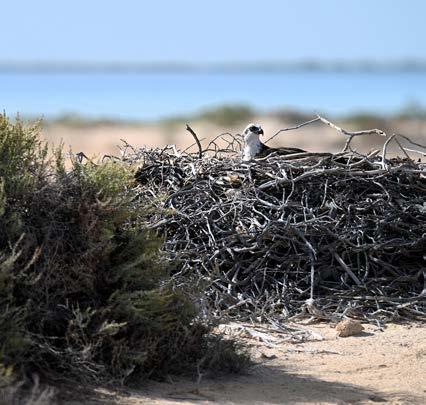
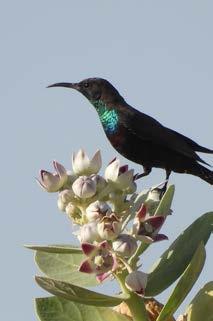


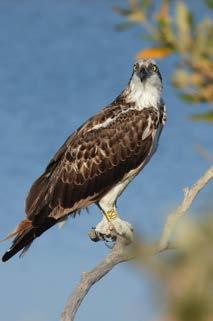




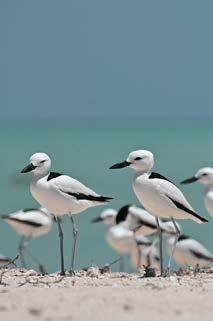


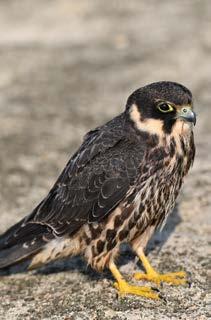
Table 06 List of islands within Al Wajh Bank and criteria. Keywords: R= Regional level, G= Global level. See Ferreira et al. (2024) for more details.
Island Criteria of selection Important Species Conservation Status Main threat (IUCN)
Quman Majority of population is breeding; Higher diversity of priority species Sooty Falcon; Bridled Tern; Whiteeyed Gull ENR LC, LC 1.3 (Tourism & recreation areas)
Breem Single priority species; Majority of population is breeding; Higher diversity of priority species Brown Booby; Saunders’s Tern LC 1.3 (Tourism & recreation areas)
Al-Kaabiah Single priority species Greater Crested Tern LC Al-Numaniat 2 Single priority species Eurasian Spoonbill LC
Abu Laheq Higher diversity of priority species; Majority of population is breeding Bridled Tern
Al-Osh Al-Sharqi Higher diversity of priority species; presence of threatened shorebirds Crab Plover; Sooty Gull; Bridled Tern; White-cheeked Tern; Ruddy Turnstone; Dunlin. VUR LC, LC, LC; NTG NTG
Al-Radeem Higher diversity of priority species; Majority of population is breeding; presence of threatened shorebirds and herons Lesser Crested Tern; Bridled Tern; Dunlin, Greater Sand Plover; Goliath Heron; Grey Heron
(Tourism &
LC; NTG NTR ENR NTR 8.1 (Invasive species)
Mardunah Majority of population is breeding Sooty Gull; Sooty Falcon LC, ENR Ghawar Majority of population is breeding; Diversity of herons Sooty Gull; Sooty Falcon; Crab Plover; Goliath Heron; Grey Heron; Purple Heron LC, ENR VUR ENR NTR NTR 8.1 (Invasive species: rat)
Ataweel Majority of population is breeding Bridled Tern; Sooty Gull; Whiteeyed Gull; Whitecheeked Tern; Crab Plover; Ruddy Turnstone; Dunlin; Greater Sand Plover; Greater Sand Plover
Shimmuzah (1+2)
Al-Shaykh Marbat
Majority of population is breeding; high concentration of threatened shorebirds
White-eyed Gull; Crab Plover; Bridled Tern; Ruddy Turnstone; Greater Sand Plover; Bar-tailed Godwit; Greater Sand Plover
LC, LC, LC, LC, VUR NTG NTG NTR; VUG
LC, VUR LC; NTG NTR NTG VUG 8.1 (Invasive species)
Majority of population is breeding Crab Plover; Sooty Gull;Whitecheeked Tern; Lesser Crested Tern; Bridled Tern VUR LC, LC, LC, LC
Al-Waqadi Majority of population is breeding Lesser Crested Tern LC 8.1 (Invasive species: cat)
Al-Numaniat 3 Majority of population is breeding Crab Plover VUR
Sheybarah North Majority of population is breeding; Diversity of herons White-eyed Gull; Goliath Heron; Grey Heron; Purple Heron LC; ENR NTR NTR 8.1 (Invasive species)
Umairat Majority of population is breeding Crab Plover VUR
Suwayhill (1+2) High concentration of threatened shorebirds and herons; Majority of population is breeding Ruddy Turnstone; Dunlin; Curlew Sandpiper; Siberian Sand Plover; Bar-tailed Godwit; Eurasian Curlew; Greater Sand Plover; Goliath Heron; Sooty Falcon NTG, NTG, VUG, ENG, NTG, NTG, VUG; ENR, ENR 8.1 (Invasive species)
Mutiat (1+2) High concentration of threatened shorebirds Ruddy Turnstone; Dunlin; Bartailed Godwit; Greater Sand Plover NTG, NTG, NTG, VUG 8.2 (Problematic native species: camel)
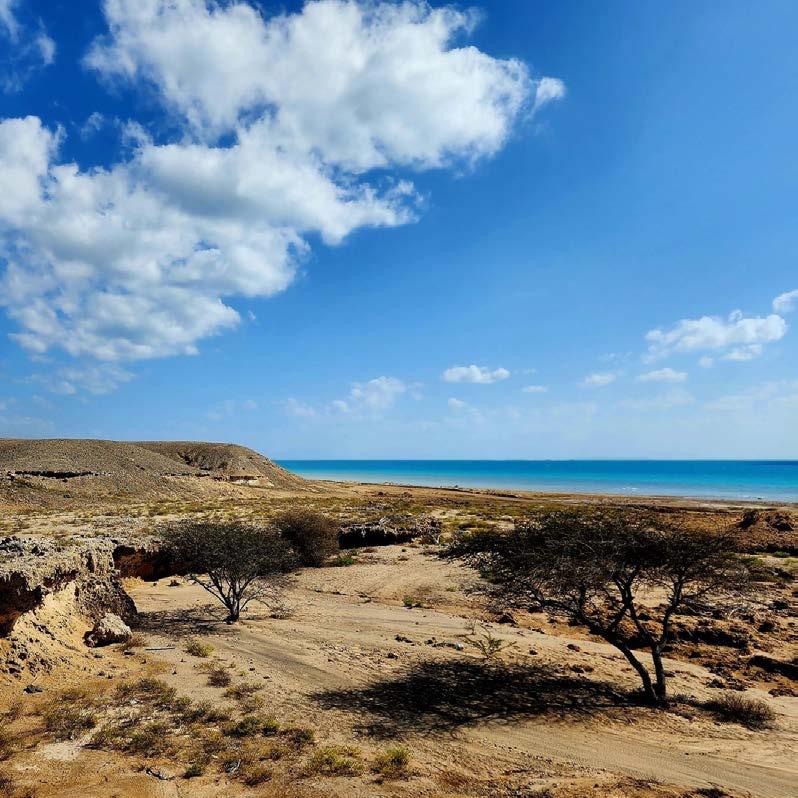
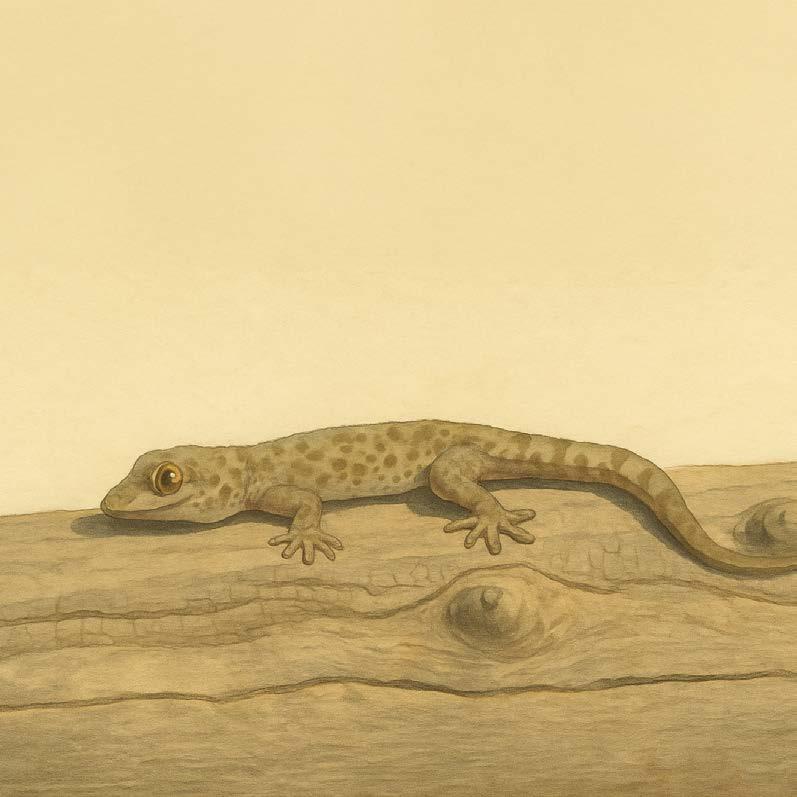
Hemidactylus sp. nov.
CLASSIFICATION Local & Global
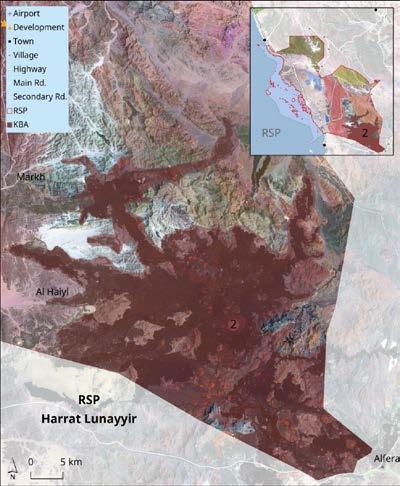
1,211
CENTRAL COORDINATES
Latitude: 25.1926
Longitude: 37.779
Terrestrial
(m)
339 to 1,471

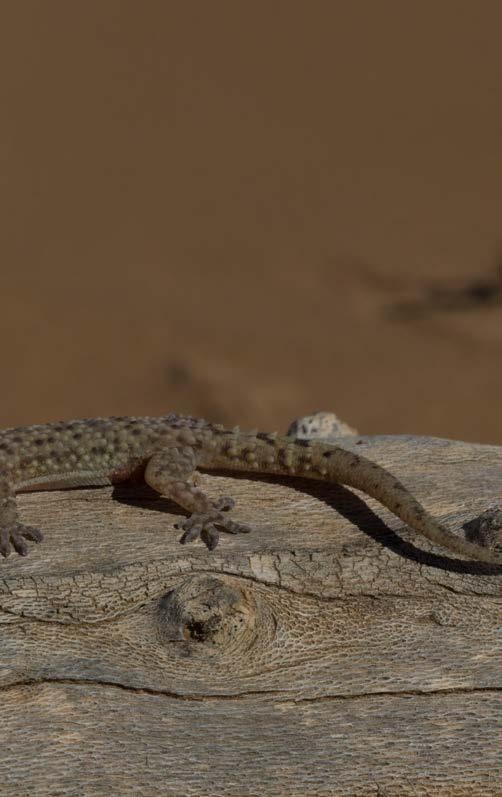


1,211
Latitude: 25.1926
Longitude: 37.779
Terrestrial
339 to 1,471
The Red Sea destination's Harrat Lunayyir was classified due to its significance for the conservation of biodiversity. This area supports seven species of flora and 19 species of fauna that are of conservation concern, three bat roosts that are locally important, and includes a considerable area
that still classifies as Last of the Wild (45% of the KBA). Significant species of flora include Hippocrepis constricta classified as Vulnerable in the Red Sea zone region. Significant species of fauna include Bonelli’s Eagle and Fantailed Raven, both classified as Endangered in the Red Sea zone region.
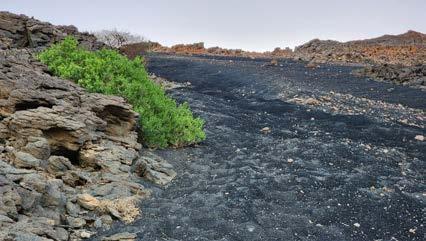
This site qualifies as a KBA of local-Red Sea zone significance that meets several thresholds for the identification of KBA, namely: Criterion A1 (two EN and five VU species), B1 (10 geographically restricted species), B2 (11 endemic species), C (considerable area classified as Last of the Wild), and D2 (1 high priority and 2 low priority bat roosts.
Table 07 | Biodiversity elements triggering KBA criteria. Keywords: L= Local-Red Sea zone level, R= Regional level. See Ferreira et al. ( 2024 ) for more details.
Vascular plants Asteriscus graveolens Yes
Corchorus depressus Yes
Hippocrepis constricta VU
Medicago laciniata Yes
Morettia parviflora Yes
Solanum incanum Yes
Trigonella stellata Yes
Mammals Cape Hare VU
Geoffroy’s Myotis VU Birds Arabian Partridge Yes
Bonelli’s Eagle EN Arabian Sunbird Yes
Fan-tailed Raven EN Arabian Serin VU Yes
Desert Tawny Owl VU Reptiles Israeli Mole Viper Yes
Hemidactylus sp. nov. 3 Yes
Hejaz Black–collared Snake Yes Arabian Cat Snake Yes
Dark Striped Scorpion Yes Eclipse Deathstalker
Arabian Burrowing Scorpion Yes Insects Scotti’s Ground Beetle Yes Yes
Eucymatodera Beetle Yes
Blue Pansy Yes
Arabian Oxycara Yes
C Last of the Wild (km2): 552
Three bat roosts were located in this KBA: Roost 8 of high priority and Roosts 5 and 9 of low priority. Roost 8 was classified as high
8 (high priority), specific measures should be applied. This roost was characterised by holes in rocks accessible to humans,
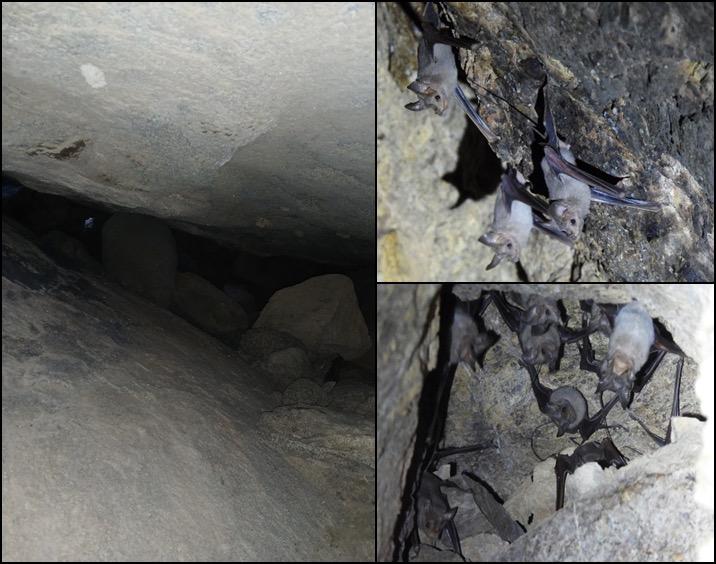
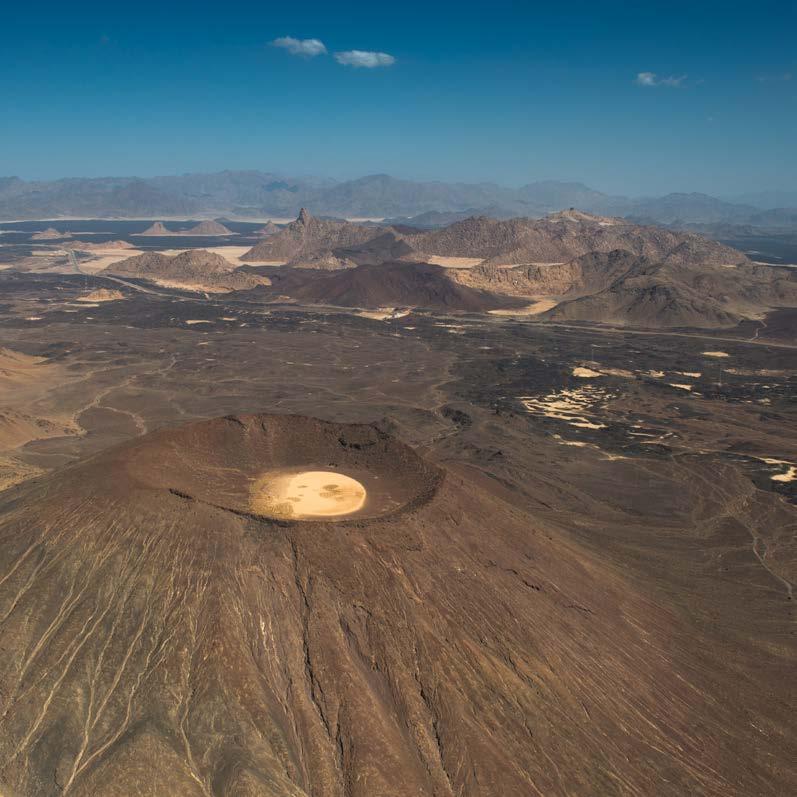

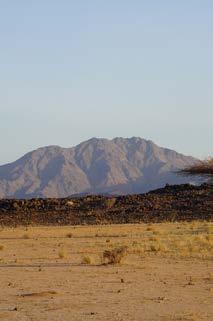

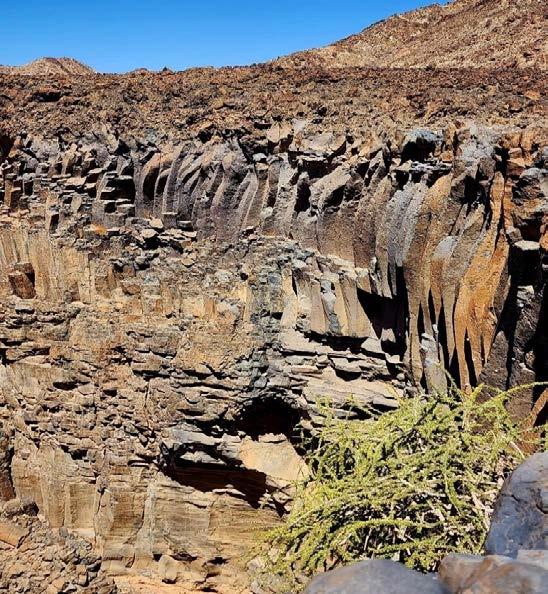

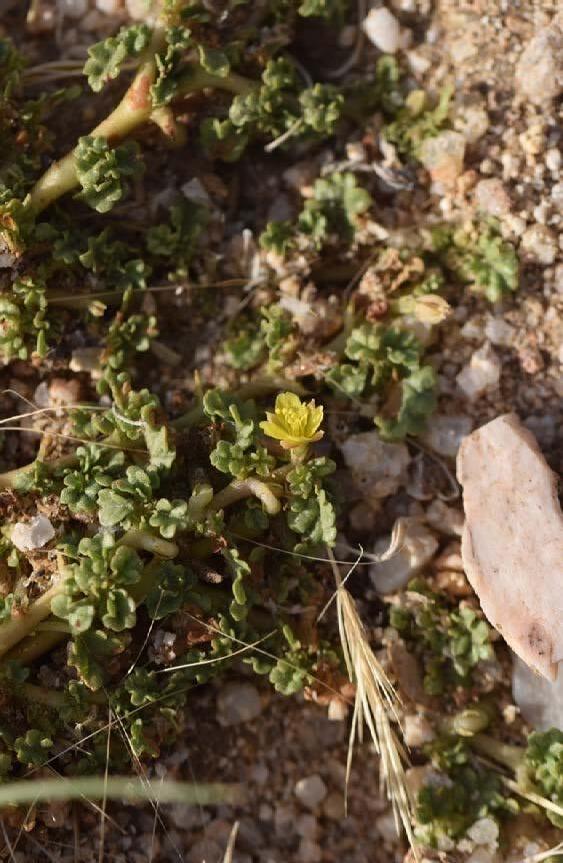

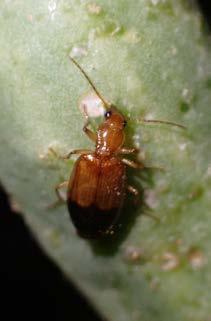
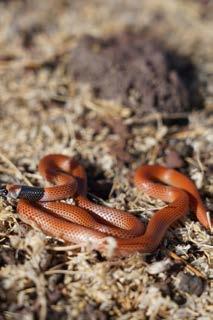


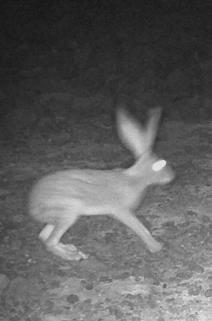
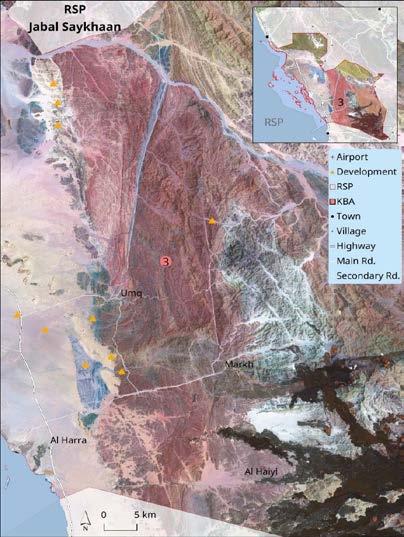
AREA OF KBA (km2)
1,643

Latitude: 25.4760
Longitude: 37.4232
Terrestrial
CENTRAL COORDINATES SYSTEM ELEVATION (m)
115 to 773
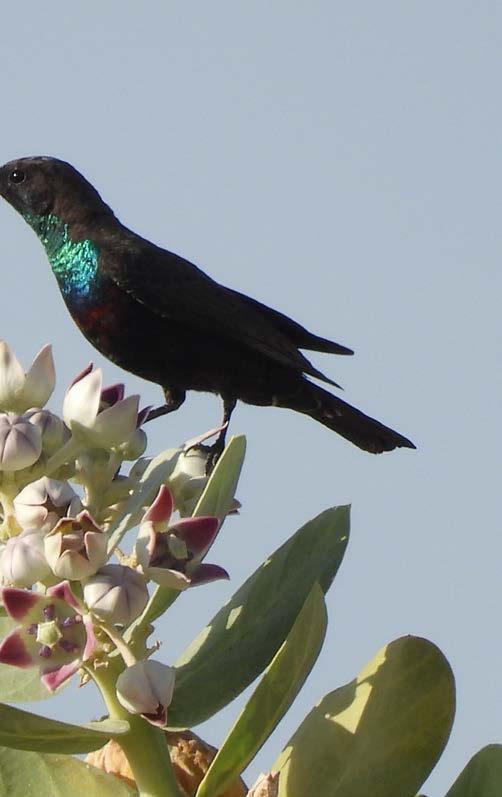
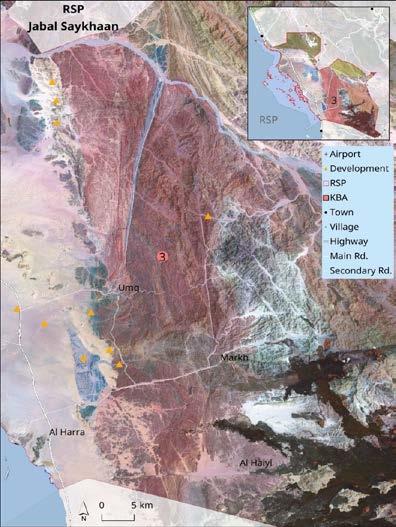


1,643
RATIONALE FOR QUALIFYING AS KBA
The Red Sea destination's Jabal Saykhaan was classified due to its significance for the conservation of biodiversity. This area supports 16 species of flora and 16 species of fauna that are of conservation concern and includes a considerable area that still classifies as Last of the Wild (27% of the KBA). Significant species of flora
include Anisosciadium lanatum classified as Critically Endangered in the Red Sea zone region.
Significant species of fauna include Arabian Woodpecker and Peregrine Falcon, both classified as Critically Endangered in the Red Sea zone region.
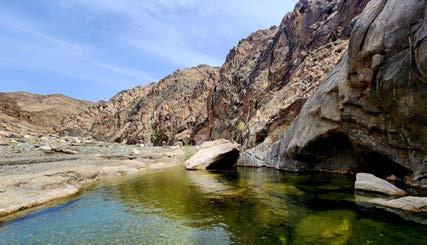
This site qualifies as a KBA of local-Red Sea zone significance that meets several thresholds for the identification of KBA, namely: Criterion A1 (three CR and six VU species), B1 (15 geographically restricted species), B2 (13 endemic species), and C (considerable area classified as Last of the Wild).
Table 08 | Biodiversity elements triggering KBA criteria. Keywords: L= Local-Red Sea zone level, R= Regional level. See Ferreira et al. ( 2024 ) for more details.
Vascular plants Anisosciadium lanatum CR Yes Yes
Cleome pallida Yes
Convolvulus oxyphyllus Yes
Hibiscus micranthus VU
Morettia parviflora Yes Yes
Polygala sinaica Yes Yes
Mammals Cheesman’s Gerbil Yes Yes
Large Aden Gerbil Yes Yes
Gerbillus sp. nov.1 Yes Yes
Geoffroy’s Myotis VU
Birds Arabian Partridge Yes Yes
Pharaoh Eagle-owl VU
Arabian Sunbird Yes Yes
Arabian Serin VU Yes Yes
Arabian Woodpecker CR Yes Yes
Peregrine Falcon CR
Reptiles Mount Elba Snake-eyed Lizard VU Yes
Saharan Racer Yes
Amphibians Oman Toad VU Yes Yes
Scorpions Eclipse Deathstalker Yes Yes
Insects Madagascar Beetle Yes
Arabian Oxycara Yes Yes
Crit. C Last of the Wild (km2): 450
Crit. B4, D2, D3 Wetlands (km2): 0.8
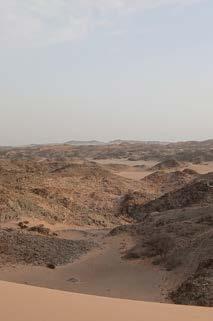



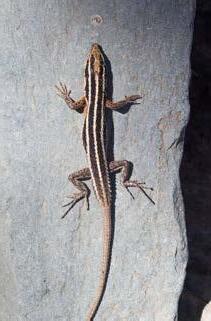
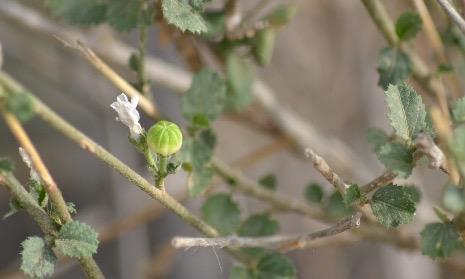
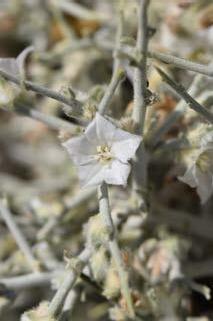


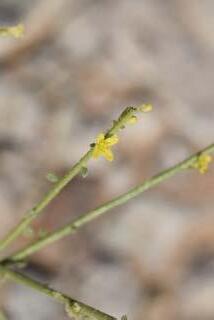


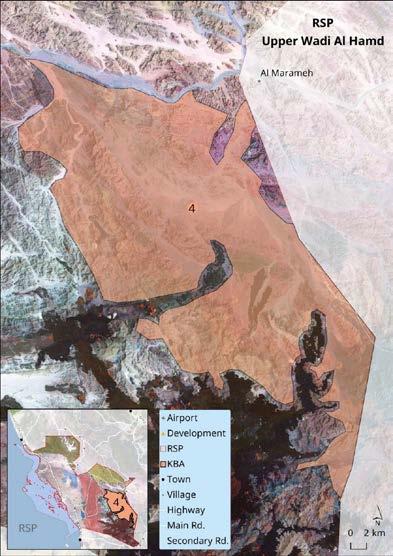

976

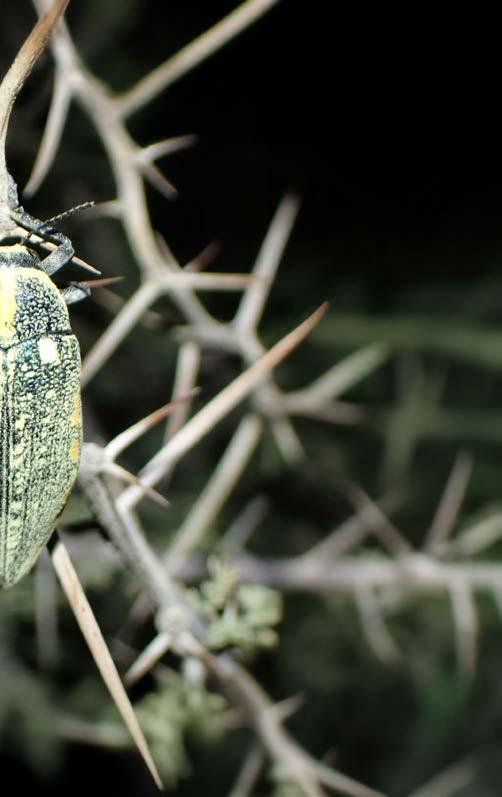


RATIONALE FOR QUALIFYING AS KBA
The Red Sea destination's Upper Wadi Al Hamd was classified due to its significance for the conservation of biodiversity. This area supports one species of flora and nine species of fauna that are of conservation concern and includes a considerable area that still classifies as Last of the Wild (33% of the KBA). Significant species of flora
include Morettia parviflora an endemic plant of the Arabian Peninsula. Significant species of fauna include Arabian Woodpecker, Arabian Wolf, and Nubian Ibex, the former classified as Critically Endangered and the latter pair as Endangered in the Red Sea zone region.
Vascular plants
Mammals
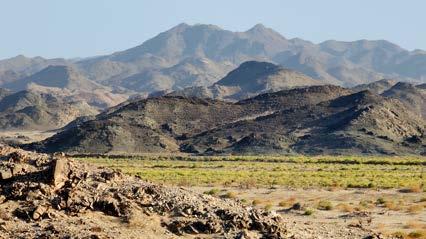
Birds
Scorpions
Insects
Table 09 | Biodiversity elements triggering KBA criteria. Keywords: L= Local-Red Sea zone level, R= Regional level. See Ferreira et al. ( 2024 ) for more details.
Morettia parviflora Yes
Arabian Wolf EN
Nubian Ibex EN Yes
Geoffroy’s Myotis VU
Egyptian Slit-faced Bat VU
Arabian Partridge Yes
Short-toed Snake-eagle VU
Arabian Woodpecker CR Yes
Eclipse Deathstalker Yes
Orange Patched Jewel Beetle Yes
Crit. C Last of the Wild (km2): 319
This site qualifies as a KBA of local-Red Sea zone significance that meets several thresholds for the identification of KBA, namely: Criterion A1 (one CR, two EN and three VU species), B1 (two geographically restricted species), B2 (four endemic species), and C (considerable area classified as Last of the Wild).
REPRESENTATIVE PHOTOS




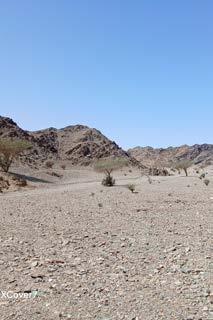
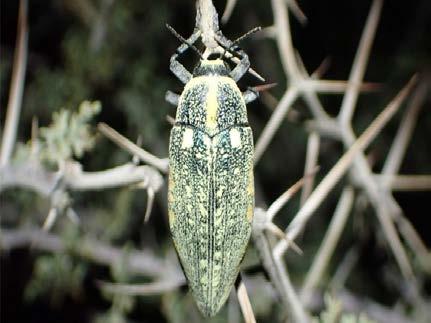

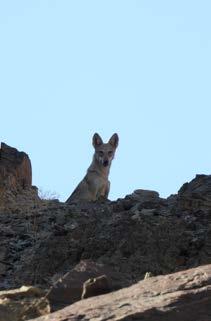

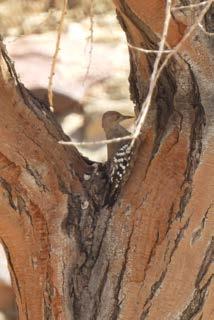
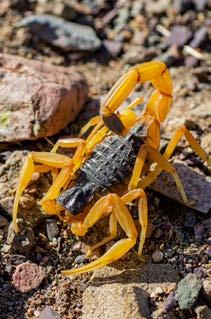

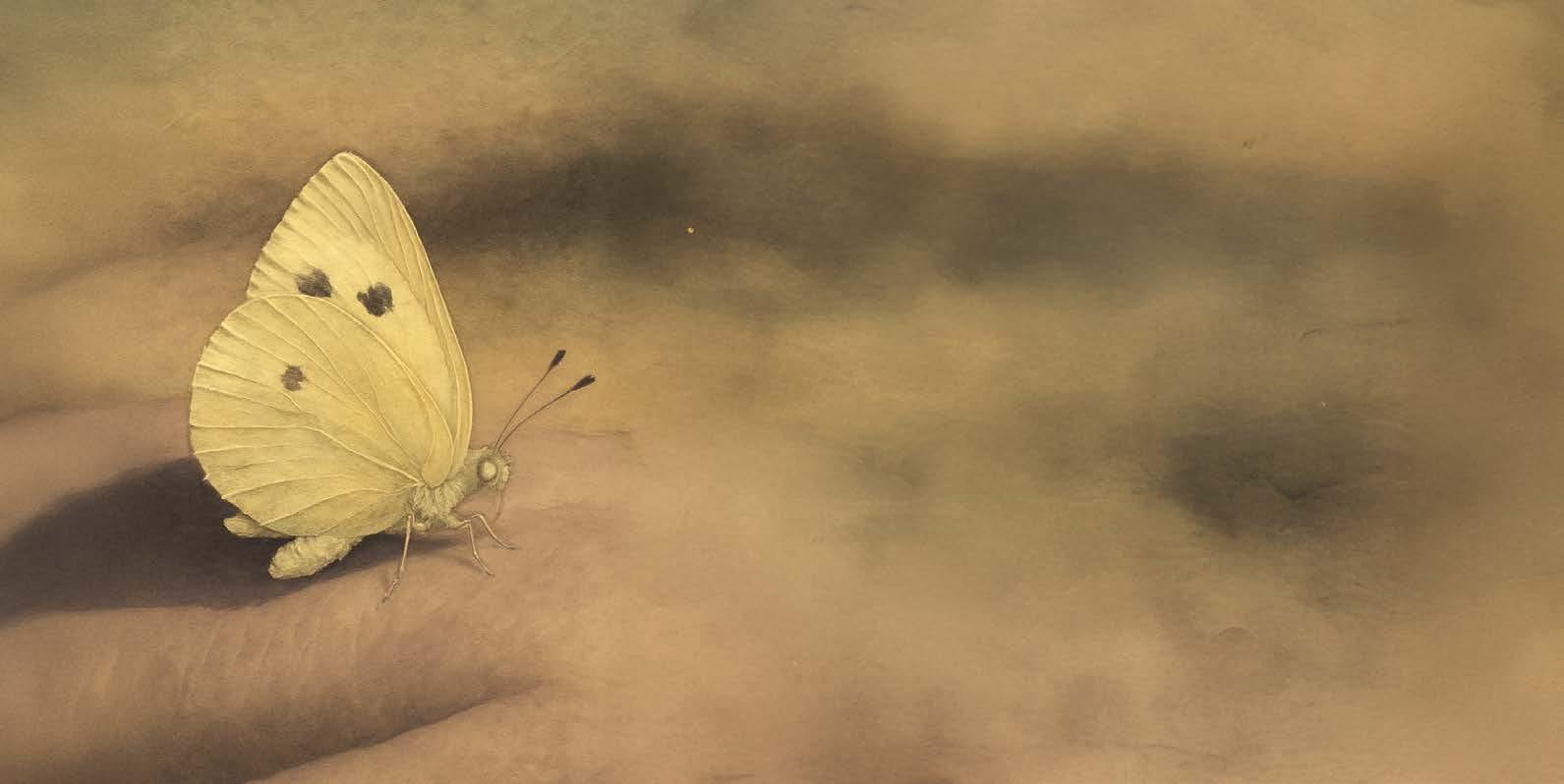
Blue-spotted Arab
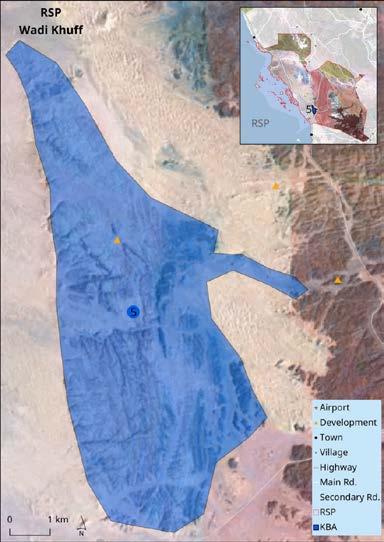
Latitude: 25.3498
Longitude: 37.2948
Terrestrial 106 to 211 AREA OF KBA (km2)
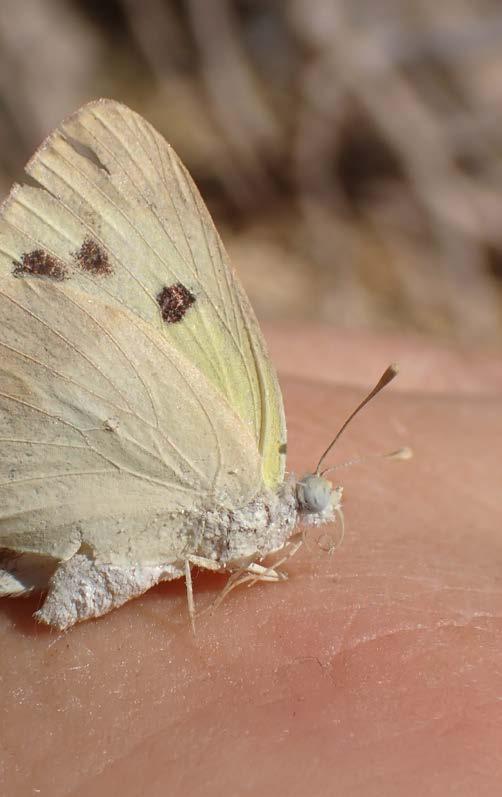
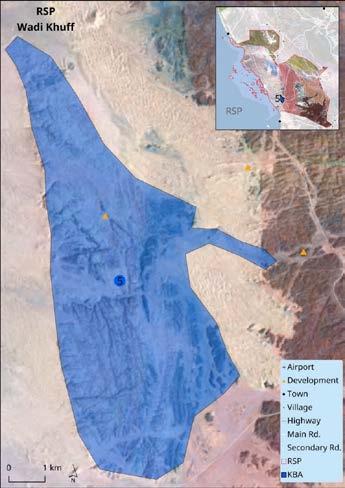



RATIONALE FOR QUALIFYING AS KBA
The Red Sea destination's Wadi Khuff was classified due to its significance for the conservation of biodiversity. This area supports 10 species of fauna that are of conservation concern and includes a considerable area that is a wetland (7% of the KBA). Significant species of fauna include Hemprich’s Desert Bat and Shorttoed Snake-eagle that classify as Vulnerable in the Red Sea zone region.
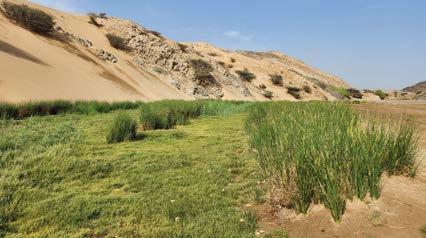
This site qualifies as a KBA of local-Red Sea zone significance that meets several thresholds for the identification of KBA, namely: Criterion A1 (two VU species), B1 (three geographically restricted species), B2 (five endemic species), and B4, D2 and D3 (considerable area covered by wetlands).
Table 10 | Biodiversity elements triggering KBA criteria. Keywords: L= Local-Red Sea zone level, R= Regional level. See Ferreira et al. ( 2024 ) for more details.
Group Species Crit. A Crit. B1 Crit. B2
ThreatenedL Geog. RestrictedL EndemicR
Mammals Cheesman’s Gerbil Yes
Hemprich’s Desert Bat VU
Kuhl’s Pipistrelle Yes
Birds Arabian Sunbird Yes
Short-toed Snake-eagle VU
Reptiles Hemidactylus sp. nov. 3 Yes
Scorpions Dark Striped Scorpion Yes
Eclipse Deathstalker Yes
Insects Bluespotted Arab Yes
Epaulet Skimmer Yes
Crit. B4, D2, D3 Wetlands (km2): 2.55
The site includes a series of small sized freshwater springs inside Wadi Khuff, that accumulate freshwater along almost 400 m inside a mountain canyon. Despite the small size of the wetland, it is of high relevance to the local-Red Sea zone fauna.
REPRESENTATIVE PHOTOS OF
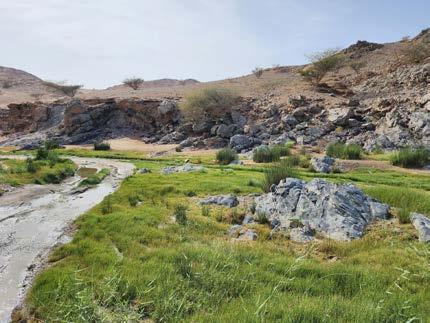


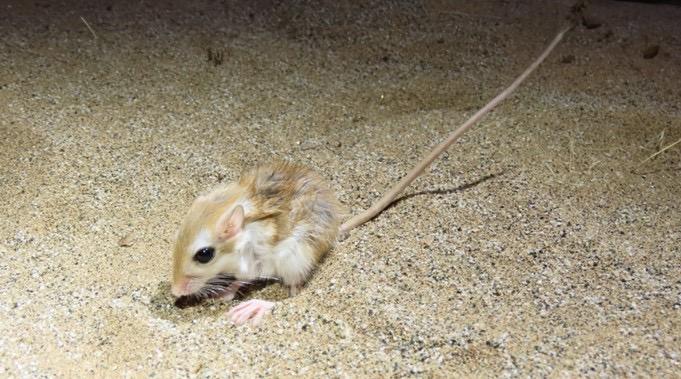
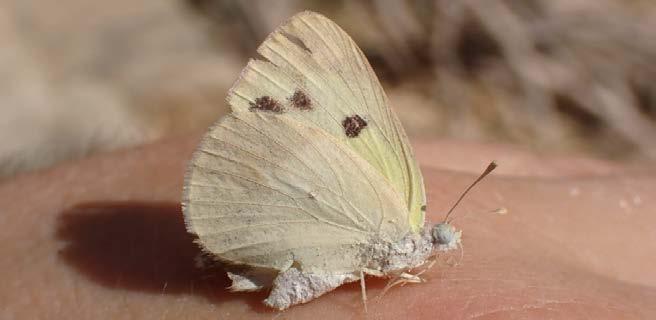


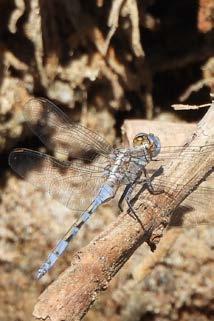




383
CENTRAL COORDINATES
Latitude: 25.7410
Longitude: 37.3128
Terrestrial
37 to 423
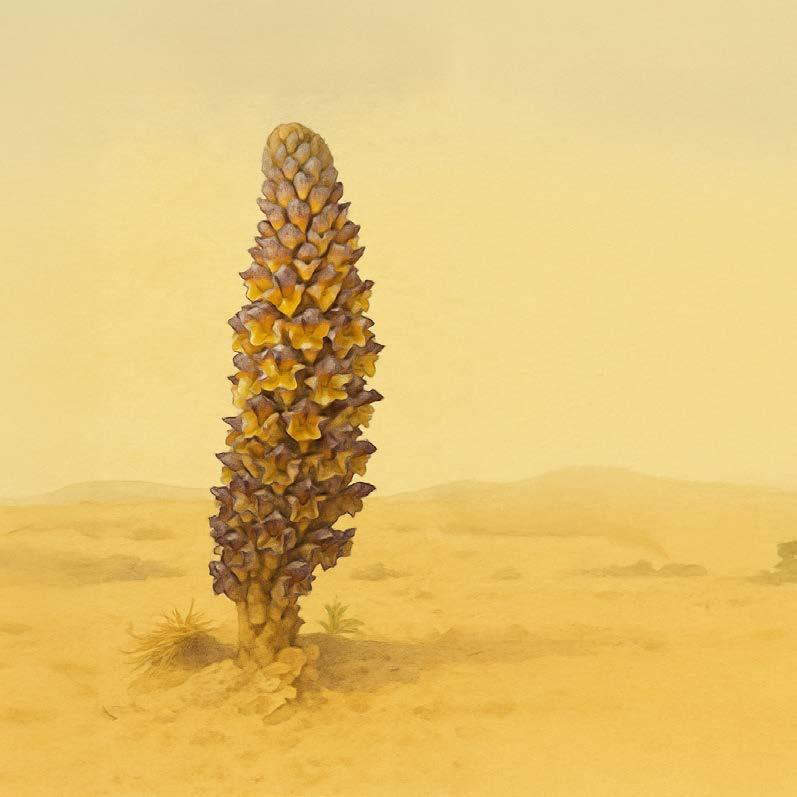
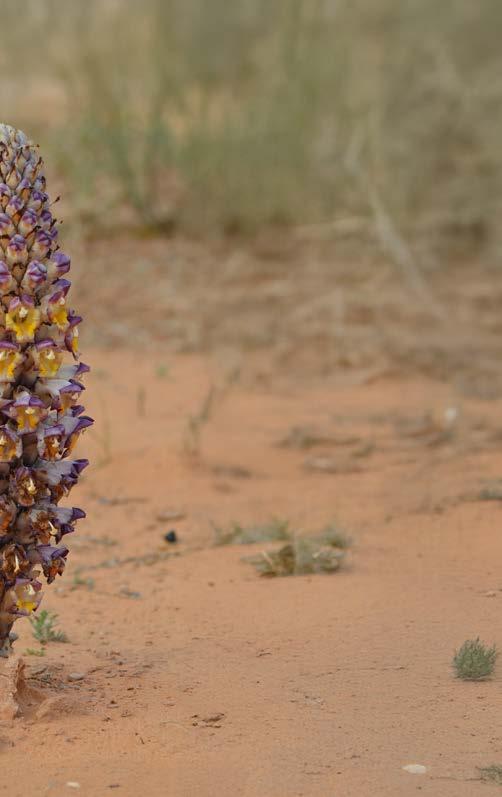


SITE
DETAILS
RATIONALE FOR QUALIFYING AS KBA
The Red Sea destination's Wadi Al Hamd was classified due to its significance for the conservation of biodiversity. This area supports seven species of flora and 16 species of fauna that are of conservation concern and includes a considerable area that is a wetland (38% of the KBA) and that still classifies as Last of the Wild (53% of the KBA). Significant species of
flora include Monsonia heliotropioides that classify as Endangered in the Red Sea zone region. Significant species of fauna include Arabian Woodpecker, Bonelli's Eagle, Euasian Spoonbill, and Killifish, the former classified as Critically Endangered and the latter trio of species as Endangered in the Red Sea zone region.
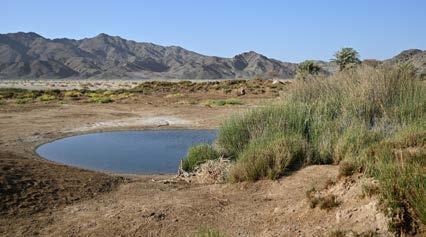
This site qualifies as a KBA of local-Red Sea zone significance that meets several thresholds for the identification of KBA, namely: Criterion A1 (one CR, four EN and five VU species), B1 (eight geographically restricted species), B2 (seven endemic species), C (considerable area classified as Last of the Wild), and B4, D2 and D3 (considerable area covered by wetlands).
Table 11 | Biodiversity elements triggering KBA criteria. Keywords: L= Local-Red Sea zone level, R= Regional level. See Ferreira et al. ( 2024 ) for more details.
Astragalus sieberi
Cistanche tubulosa
Corchorus depressus Yes
Hippocrepis constricta VU
Monsonia heliotropioides EN Yes
Polygala sinaica
Cheesman’s Gerbil
Geoffroy’s Myotis VU
Fat Sand Rat Yes
Birds Bonelli’s Eagle EN
Long-legged Buzzard VU
Black Scrubrobin VU
Short-toed Snake-eagle VU Arabian Woodpecker CR
Eurasian Spoonbill EN
Deathstalker
Burrowing Scorpion
Arab Mantis
Bembridge Beetle
Crit. B4, D2, D3 Wetlands (km2): 146.12
Crit. C Last of the Wild (km2): 202
The site includes the Wadi Al Hamd that accumulates water along a 120 km stretch of a mountain canyon.
This wetland is of high relevance to the local-Red Sea zone fauna.

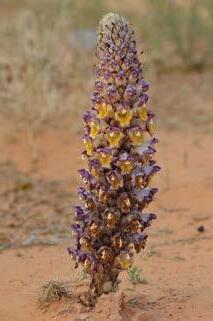


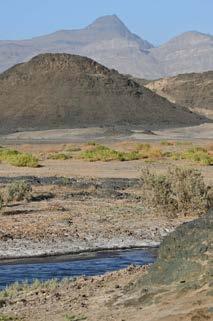


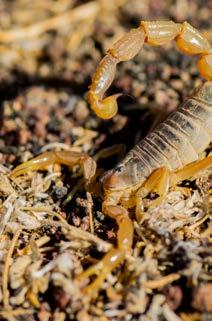
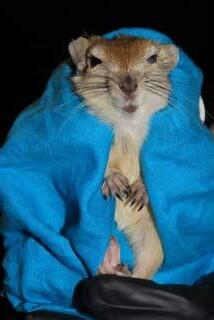


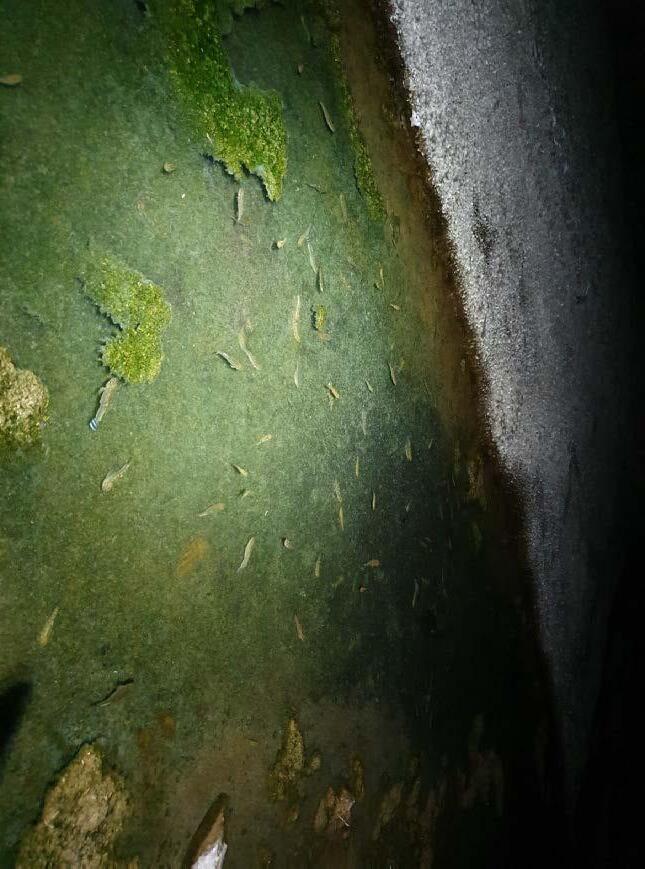
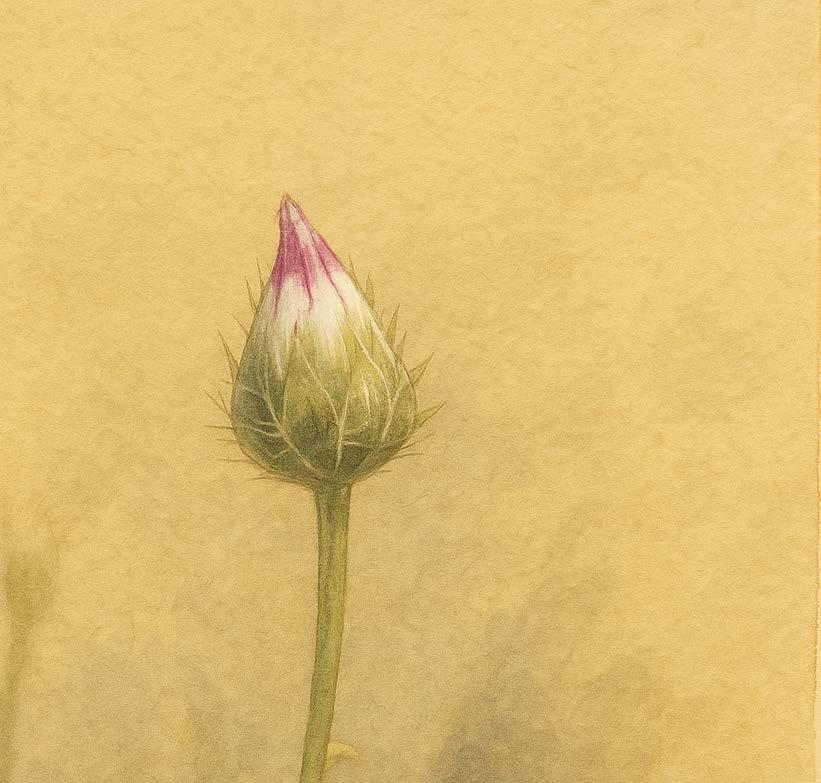

772
Latitude: 25.8329
Longitude: 37.6126 Terrestrial 137 to 1,310
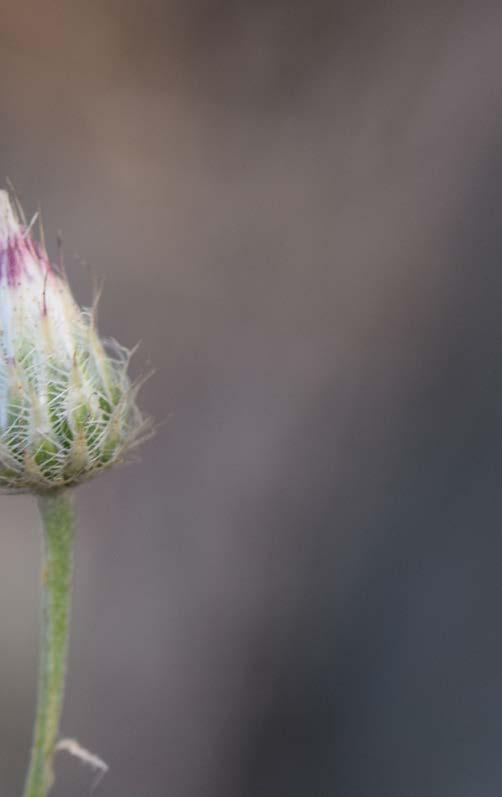



772
RATIONALE FOR QUALIFYING AS KBA
The Red Sea destination's Jabal Qawwam was classified due to its significance for the conservation of biodiversity. This area supports seven species of flora and 13 species of fauna that are of conservation concern. Significant species of flora include Salvia deserti that classify as Endangered in
the Red Sea zone region. Significant species of fauna include Geoffroy’s Myotis, Pharaoh Eagle-owl, Arabian Serin, Desert Tawny Owl, Mount Elba Snake-eyed Lizard, and Oman Toad, all classified as Vulnerable in the Red Sea zone region.
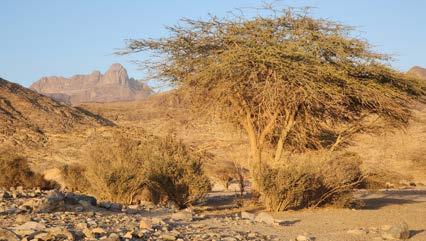
Red Sea zone significance that meets several thresholds for the identification of KBA, namely: Criterion A1 (one EN and six
VU species), B1 (12 geographically restricted species), and B2 (eight endemic species).
Table 12 | Biodiversity elements triggering KBA criteria. Keywords: L= Local-Red Sea zone level, R= Regional level. See Ferreira et al. ( 2024 ) for more details.
Vascular plants Diplotaxis harra
Morettia parviflora
Notoceras bicorne
Plocama calycoptera
Salvia deserti EN
Tricholaena teneriffae
Zoegea purpurea
Mammals Geoffroy’s Myotis VU
Kuhl’s Pipistrelle
Partridge
Pharaoh Eagle-owl VU
Arabian Sunbird
Arabian Serin VU
Desert Tawny Owl VU
Reptiles Mount Elba Snake-eyed Lizard Yes
Amphibians Oman Toad VU
Striped Scorpion
Eclipse Deathstalker
Insects Golden Arab
Large Salmon Arab
Epaulet Skimmer
Crit. B4, D2, D3 Wetlands (km2): 0.01
The site includes a permanent dam that accumulates freshwater along almost 900 m inside a mountain canyon.
Despite the small size, it is of high relevance to the local-Red Sea zone fauna.
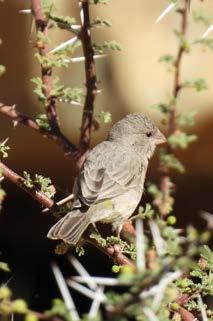








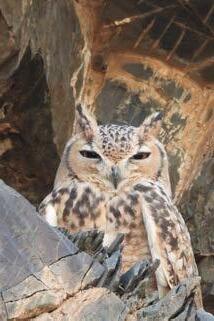
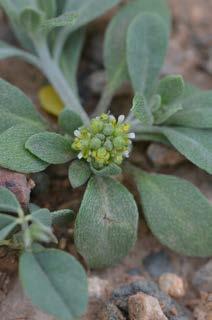

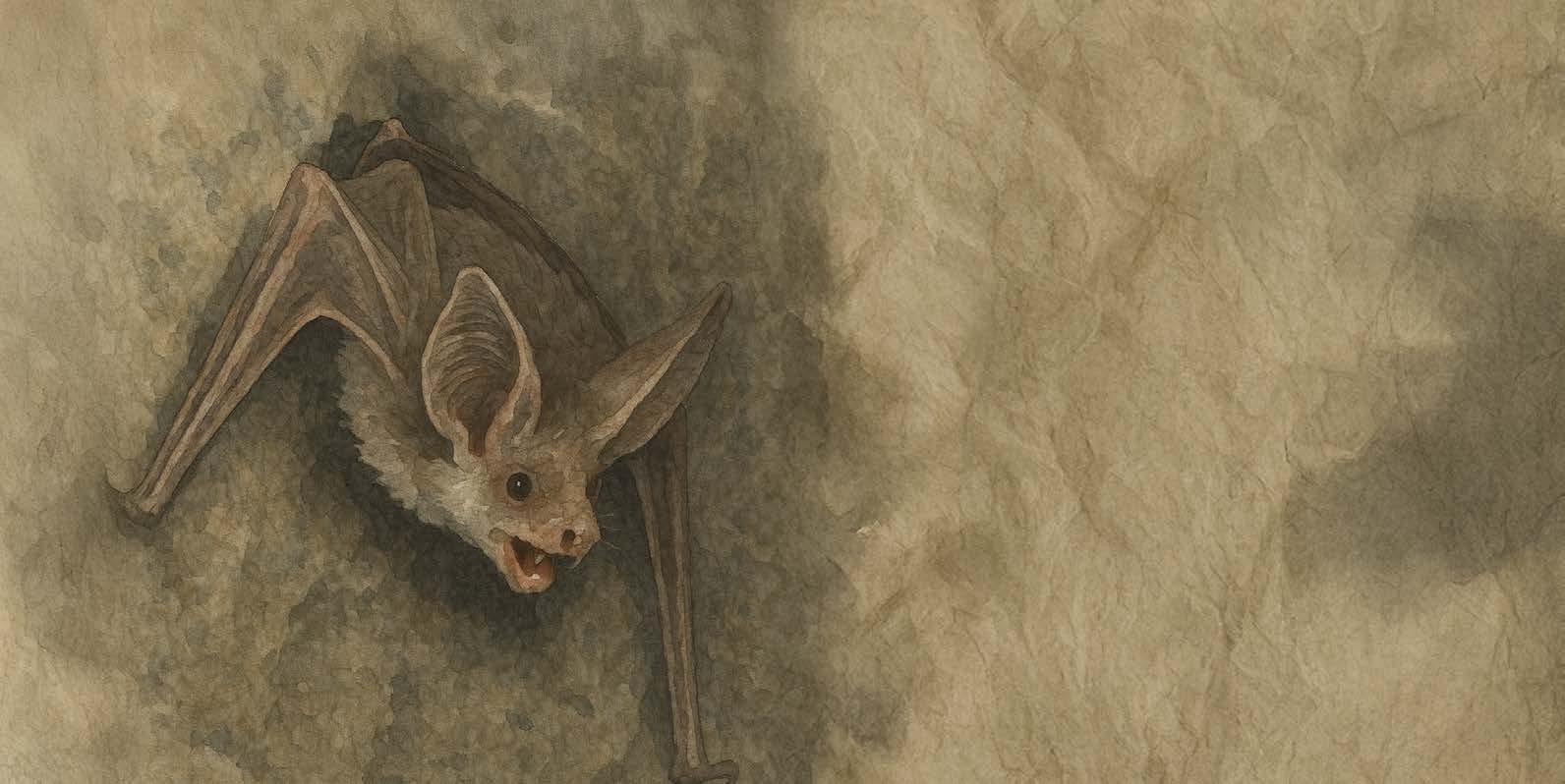

1,163
Latitude: 26.1250
Longitude: 36.9532
Terrestrial
13 to 1,140
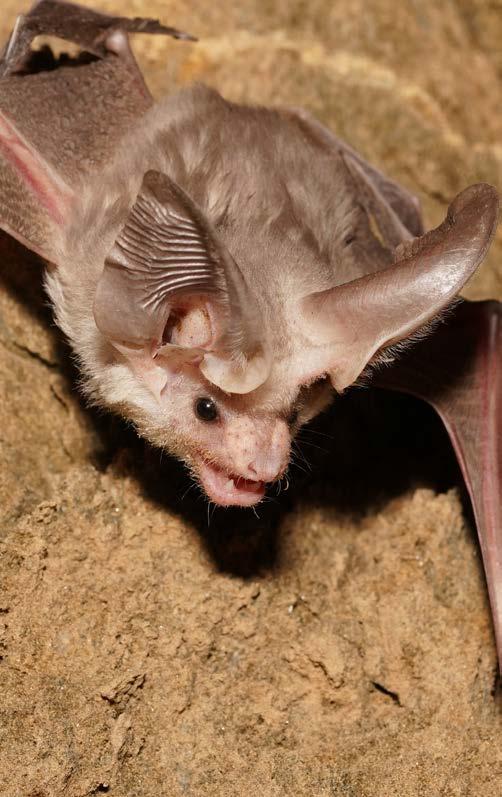


1,163
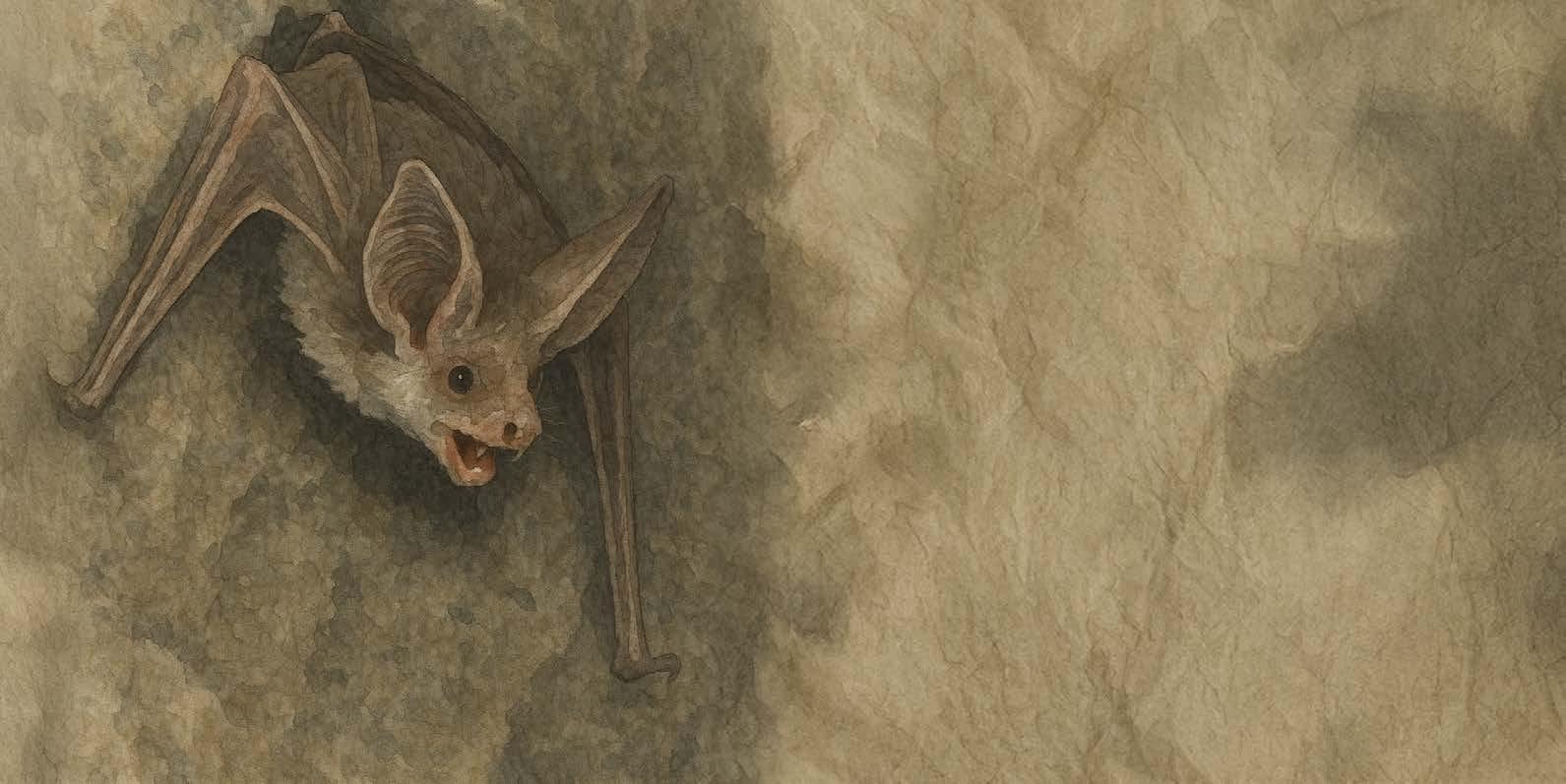
Terrestrial
13 to 1,140
RATIONALE FOR QUALIFYING AS KBA
The Red Sea destination's Jabal Ral and Northern Areas was classified due to its significance for the conservation of biodiversity. This area supports 14 species of flora and 25 species of fauna that are of conservation concern and two bat roosts that are locally important. Significant species of flora include Salvia deserti classified as Endangered in the
Red Sea zone region, as well as the single observation of Plagiochasma rupestre, the single representative of liverworts plants detected in the Red Sea zone region. Significant species of fauna include Peregrine Falcon and Bonelli’s Eagle, the former classified as Critically Endangered and the latter as Endangered in the Red Sea zone region.
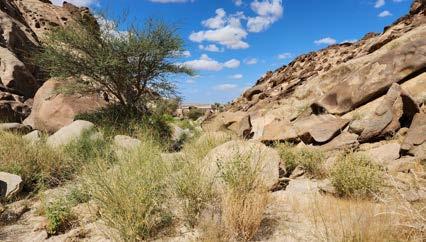
This site qualifies as a KBA of local-Red Sea zone significance that meets several thresholds for the identification of KBA, namely: Criterion A1 (one CR, two EN and 10 VU species), B1 (16 geographically restricted species), B2 (13 endemic species), C (area classified as Last of the Wild), and D2 (two low priority bat roosts).
Table 13 Biodiversity elements triggering KBA criteria. Keywords: L= Local-Red Sea zone level, R= Regional level. See Ferreira et al. ( 2024 ) for more details.
Vascular plants Capparis cartilaginea
Commiphora kataf
Eragrostis minor Yes
Ficus salicifolia Yes
Grewia tenax Yes
Hibiscus micranthus VU
Hippocrepis constricta VU
Morettia parviflora Yes
Moringa peregrina Yes
Plantago ciliata Yes
Plocama calycoptera Yes
Polygala sinaica Yes
Salvia deserti EN Yes Yes
Liverworts Plagiochasma rupestre Yes
Mammals Geoffroy’s Trident Bat Yes
Cheesman’s Gerbil Yes
Large Aden Gerbil Yes
Gerbillus sp. nov. 1 Yes
Geoffroy’s Myotis VU
Egyptian Slit-faced Bat VU
Hemprich’s Desert Bat VU
Egyptian Rousette Yes
Birds Bar-tailed Lark Yes
Bonelli’s Eagle EN
Pharaoh Eagle-owl VU
Long-legged Buzzard VU
Black Scrubrobin VU
Arabian Sunbird Yes
Arabian Serin VU Yes
Peregrine Falcon CR
Desert Tawny Owl VU
Alpine Swift Yes
Reptiles Arabian Cat Snake Yes
Amphibians Oman Toad Yes
Scorpions Khaybari Striped Scorpion Yes
Eclipse Deathstalker Yes
Arabian Burrowing Scorpion Yes
Insects Violet Checkered Beetle Yes
Arabian Oxycara Yes
Crit. B4, D2, D3 Wetlands (km2): 0.013 (13,360 m2)
Crit. C Last of the Wild (km2): 9
ADDITIONAL BIODIVERSITY NOT TRIGGERING KBA CRITERIA
Crit. D2 Bat roosts:
No specific management recommendations are needed for the lowpriority roosts as these are likely night roosts (Al Obaid et al. 2023). However, disturbance associated to human activities should be minimised in these areas whenever possible.
The site includes a series of small sized rock pools, likely seasonal, that accumlate freshwater along almost 80 m inside a mountain canyon. It also includes a freshwater spring that accumulates water along about 160 m. Despite the combined small size of both wetlands, they are of high relevance to the local-Red Sea zone fauna.


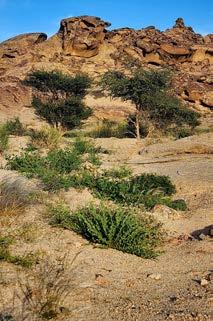

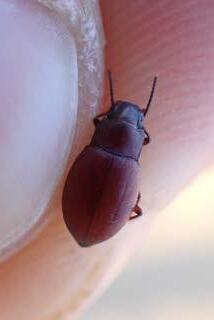

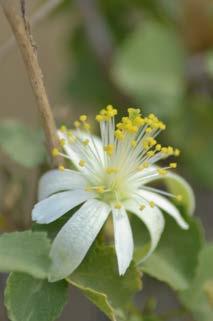

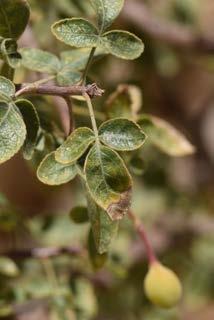

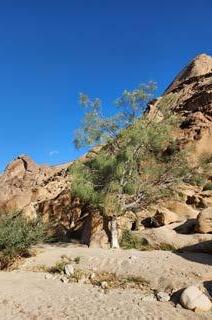


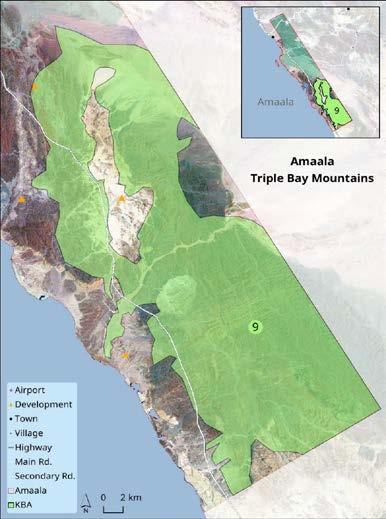
692
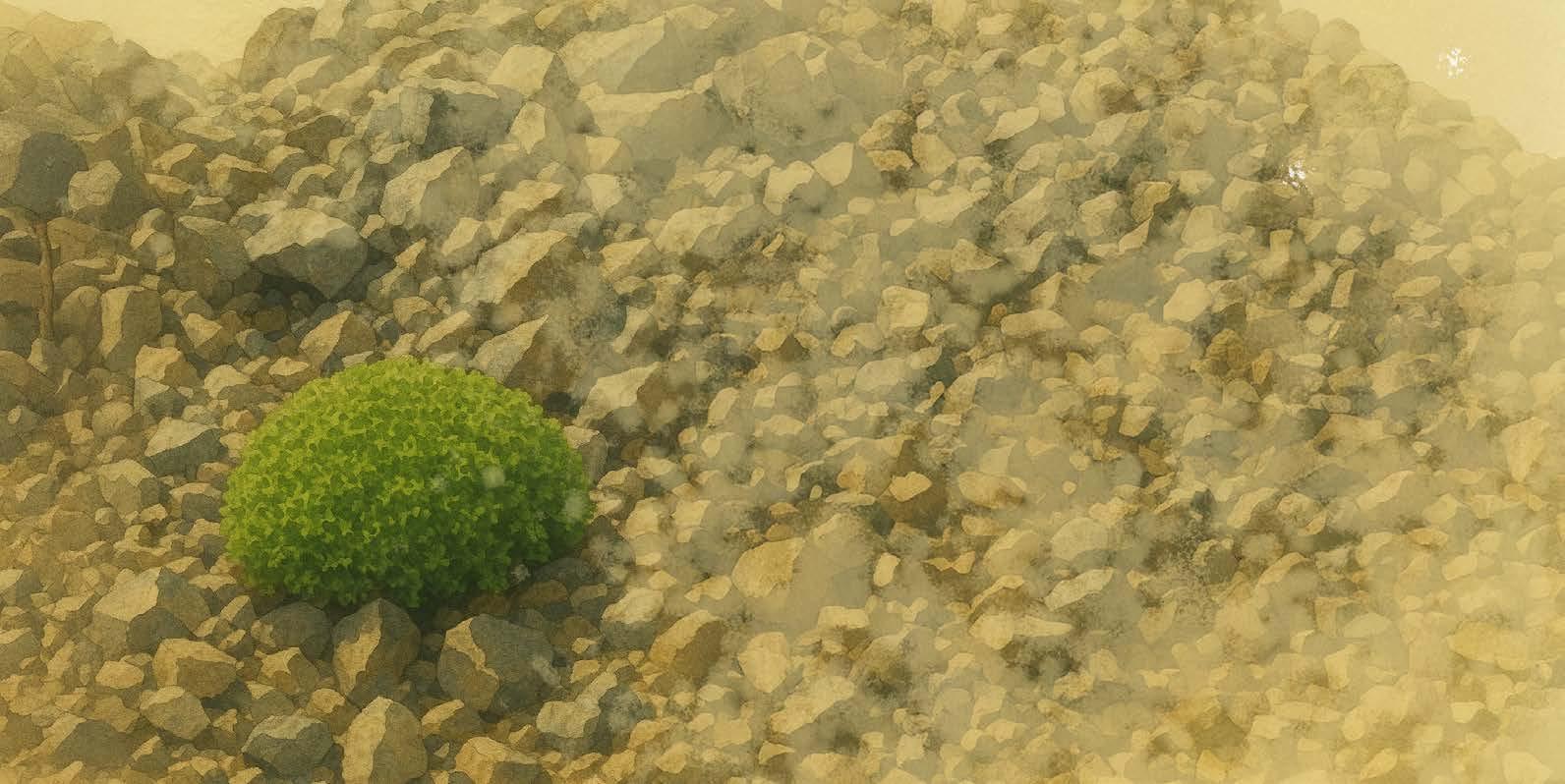
Latitude: 26.7613
Longitude: 36.2830
Terrestrial
8 to 340 AREA OF KBA (km2) CENTRAL COORDINATES




692
Terrestrial
8 to 340
RATIONALE FOR QUALIFYING AS KBA
Destination AMAALA's Triple Bay mountains were classified due to their significance for the conservation of biodiversity. This area supports 12 species of flora and 22 species of fauna that are of conservation concern, four bat roosts that are locally important, and includes a considerable area that is a wetland (2.3% of the KBA) and that still classifies as Last of the Wild (26% of the KBA).
Significant species of flora include Cleome droserifolia classified as Vulnerable in the Red Sea zone region. Significant species of fauna include Arabian Pupfish, Bonelli's Eagle, and Common Moorhen, the former classified as Critically Endangered and the latter pair of species as Endangered in the Red Sea zone region.
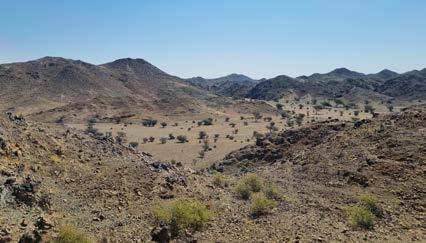
This site qualifies as a KBA of localRed Sea zone significance that meets several thresholds for the identification of KBA, namely: Criterion A1 (one CR, two EN and 10 VU species), B1 (16 geographically restricted species), B2 (eight endemic
species), C (considerable area classified as Last of the Wild), B4, D2 and D3 (considerable area covered by wetlands), and D2 (2 high priority and 2 low priority bat roost.
Table 14 Biodiversity elements triggering KBA criteria. Keywords: L= Local-Red Sea zone level, R= Regional level. See Ferreira et al. ( 2024 ) for more details.
Vascular plants Capparis spinosa Yes
Cleome droserifolia VU
Euphorbia arabica Yes
Euploca strigosa Yes
Heliotropium arbainense Yes
Juncus rigidus Yes
Kohautia caespitosa Yes
Lindenbergia indica Yes
Morettia parviflora Yes
Polygala sinaica Yes
Pulicaria undulata Yes
Vachellia oerfota Yes
Mammals Geoffroy’s Trident Bat Yes
Cheesman’s Gerbil Yes
Gerbillus sp. nov. Yes
Geoffroy’s Myotis VU
Egyptian Slit-faced Bat VU
Hemprich’s Desert Bat VU
Fat Sand Rat Yes
Egyptian Rousette Yes
Birds Bonelli’s Eagle EN
Pharaoh Eagle-owl VU
Long-legged Buzzard VU
Arabian Sunbird Yes
Short-toed Snake-eagle VU
Arabian Serin VU Yes
Common Moorhen EN Yes
Osprey VU
Spur-winged Lapwing VU
Fishes Arabian Pupfish CR Yes
Scorpions Khaybari Striped Scorpion Yes
Eclipse Deathstalker Yes
Insects Orange Patched Jewel Beetle Yes
Black Pennant Yes
Arabian Burrowing Scorpion Yes
Insects Violet Checkered Beetle Yes
Arabian Oxycara Yes
Crit. C Last of the Wild (km2): 182
Crit. B4, D2, D3 Wetlands (km2): 16.25
The site includes a wadi, that accumulates water along almost 8,000 m inside a
mountain canyon and along a bare plain. This wetland is of high relevance to the local-Red Sea zone fauna.
Crit. D2 Bat roosts:
Four bat roosts were located in this KBA:
Roosts and 4 of high priority and Roosts 2 and 3 of low priority. The two roosts identified as high priority contained individuals of the species Arabian Mousetailed Bat roosting during the day. Roost 1 contained one individual, while Roosts 4 contained around 30 individuals. The later also contained three skulls of Egyptian Rousette, however no living individual was found roosting in the site.
Since these two roosts were only sampled once, it is unknown if they are used during reproductive periods, and thus detailed studies should be conducted in the future. No specific management recommendations are needed for the lowpriority roosts as these are likely night roosts (Al Obaid et al. 2023). Regarding Roosts 1 and 4 (high priority), specific measures should be applied. These roosts were characterised by holes in rocks and abandoned mines
accessible to humans, thus these areas should be fenced to avoid human disturbance.
Fencing can be done in the surrounding area or at the entrance for big roosts but guaranteeing that bats and other wild animals can still move freely. This is especially important in Roost 4 that is located in an abandoned mine known to local-Red Sea zone people. If fencing is not possible, access to the areas should be limited during reproduction period of the bat species present in the roost. Although limited information about the reproductive cycle of bats is available for Saudi Arabia, studies indicates that reproduction usually occurs between March and August (Al Obaid et al. 2023). Hence, restrictions to access roosts should be in place during that period. Still, further study is required to understand if these roosts are used all year round and if bats use them for reproduction.
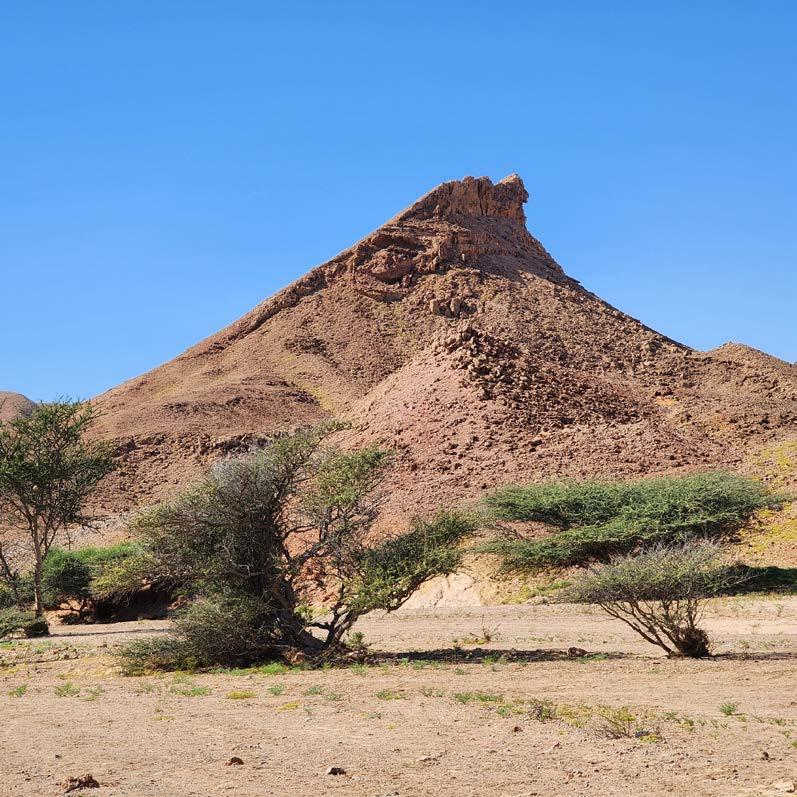
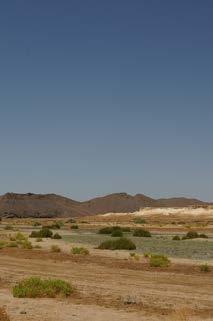


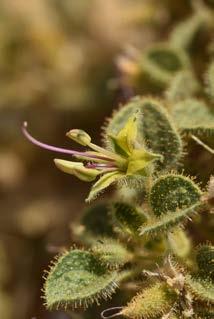




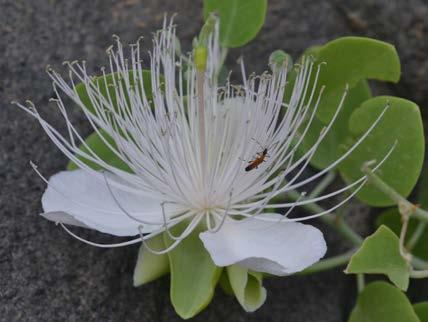


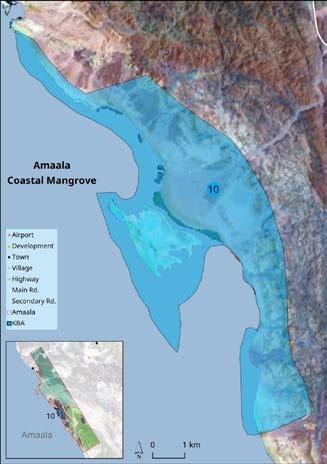
35
COORDINATES
Latitude: 26.9068
Longitude: 36.0198
Terrestrial
0 to 61
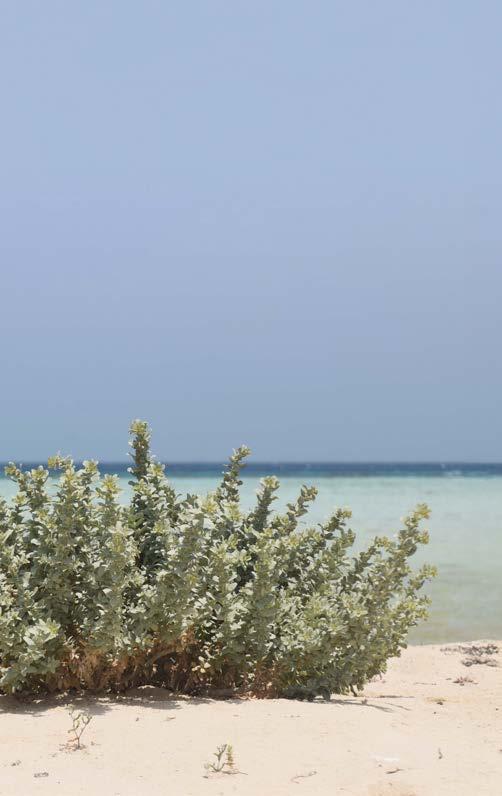



Longitude: 36.0198
Terrestrial
RATIONALE FOR QUALIFYING AS KBA
Destination AMAALA's Coastal Mangroves was classified due to its significance for the conservation of biodiversity. This area supports four species of flora and seven species of fauna that are of conservation concern and includes a considerable area of threatened mangrove (9% of the KBA). Significant species of flora include Cadaba farinosa, Indigofera coerulea, Atriplex farinosa, and Mesembryanthemum cryptanthum, all geographically restricted within the Red Sea zone region. Significant species of fauna include Purple Heron and Crab Plover, all classified as Endangered in the Red Sea zone region.
This coastal area supports a high diversity of intertidal habitats and it is located within a major migratory flyway, further highlighting
its potential to support a diverse assemblage of waterbirds. However, the biodiversity of the region, particularly on Al Numan and Zubaida islands, remains poorly studied, creating a significant knowledge gap. This lack of data limits the current understanding of the area's ecological importance, including its potential role as a nesting site for birds and as a critical stopover or wintering habitat for migratory waterbirds. Zubaida island is connected to the mainland by a sediment bridge, which may allow for species exchange between the two areas, raising concerns about the possible colonization of the island by invasive land mammals. This could have significant implications for its ecological integrity, and further research is recommended to assess these dynamics and conservation value of this KBA.
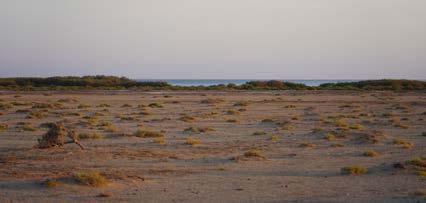
This site qualifies as a KBA of local-Red Sea zone significance that meets several thresholds for the identification of KBA, namely: Criterion A1 (two EN and two VU species), A2 (considerable area covered by a threatened ecosystem type – Mangroves),
B1 (four geographically restricted species), and B2 (two endemic species).
Crit. A2 Mangroves (km2): 3.25
Table 15 Biodiversity elements triggering KBA criteria. Keywords: L= Local-Red Sea zone level, R= Regional level See Ferreira et al. ( 2024 ) for more details.
Vascular plants Atriplex farinosa Yes
Cadaba farinosa Yes
Indigofera coerulea Yes
Mesembryanthemum cryptanthum Yes
Mammals Large Aden Gerbil Yes
Birds Purple Heron EN
Green-backed Heron VU
Crab Plover EN
Osprey VU
Scorpions Eclipse Deathstalker Yes
Insects Eleven-spotted Lady Beetle Yes
This site is important for shorebirds species that use the area as stopover and/ or wintering grounds, including Common Greenshank, Common Redshank, Common Ringed Plover, Greater Sand Plover, Whimbrel, Eurasian Curlew, Bartailed Godwit, Greater Sand Plover, Dunlin, Common sandpiper, and Terek Sandpiper. The area also supports one locally threatened harrier species, Western Marsh-harrier, which passes through during migration. Several
Ardeidae species are also frequent in the area, such as Western Reef-egret, Little Egret, and Black-crowned Night-heron. Additionally, the presence of singing Common Reedwarbler within the mangroves suggests that this site may represent the northern-most breeding area in the country for the resident subspecies of Common Reed-warbler (Acrocephalus scirpaceus avicenniae; Babbington et al 2019).

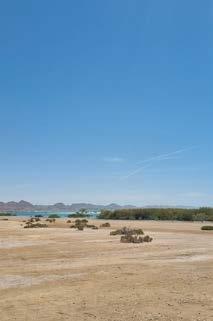

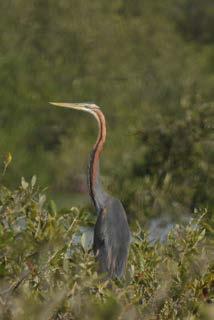
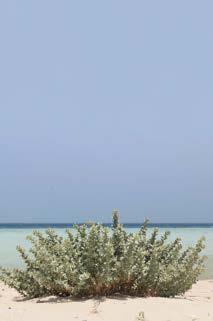

Mesembryanthemum cryptanthum (Geog. Restricted)



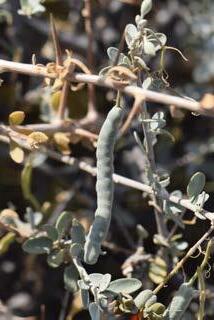
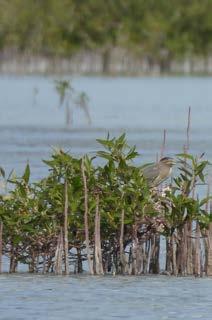

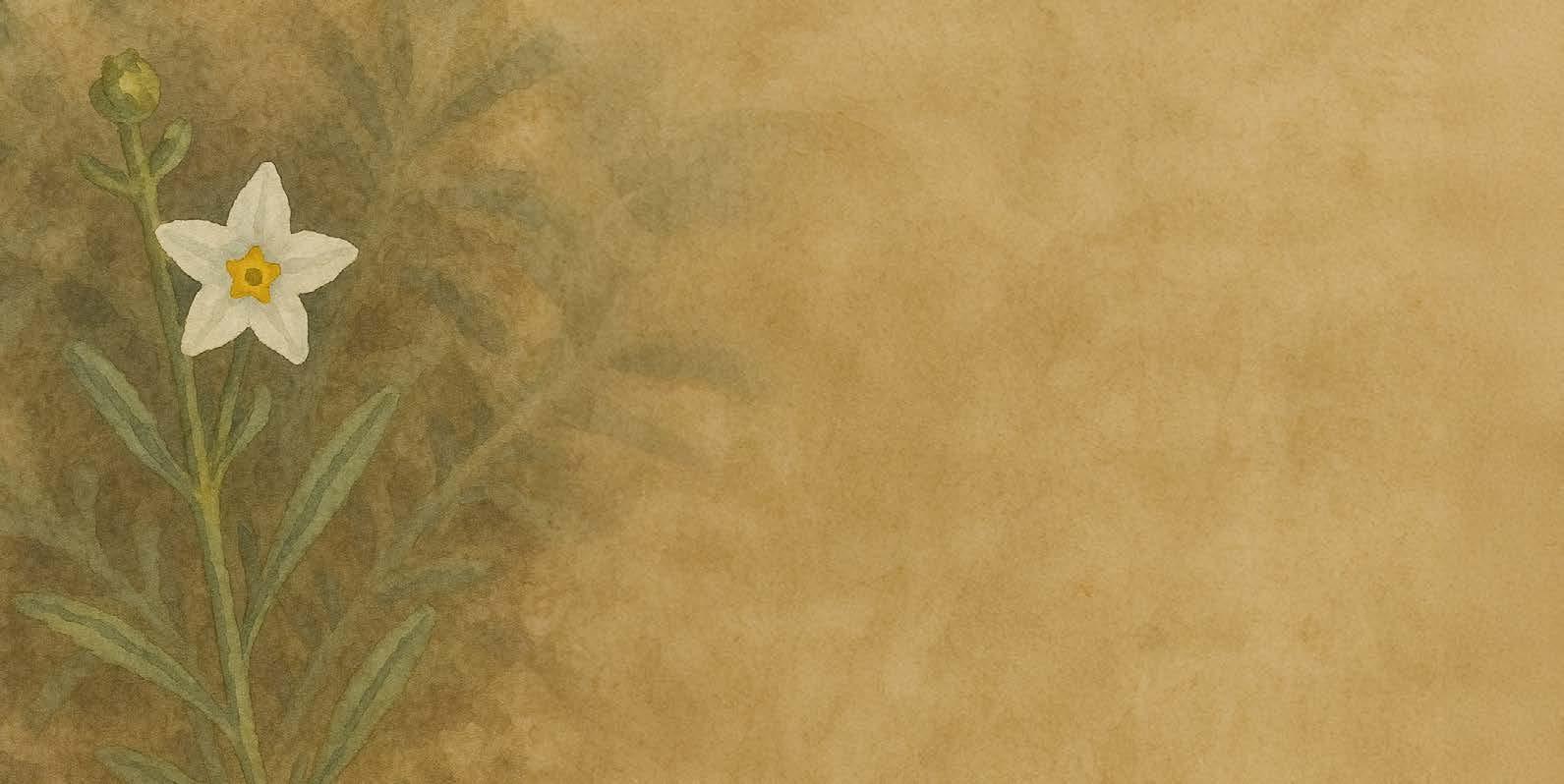
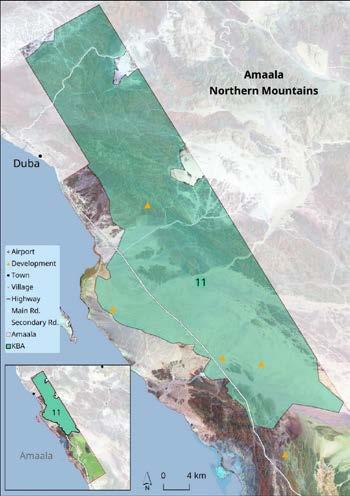
1,086
Latitude: 27.2458
Longitude: 35.9390
Terrestrial
6 to 359
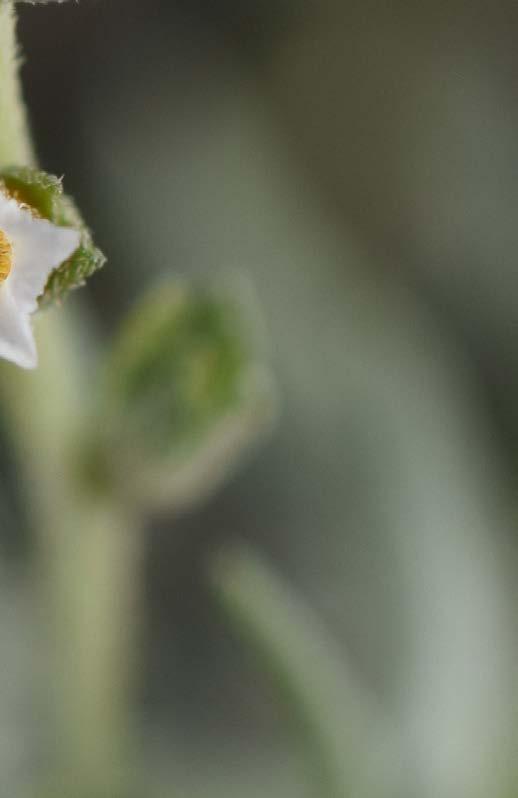



1,086
Latitude: 27.2458
Longitude: 35.9390
6 to 359
RATIONALE FOR QUALIFYING AS KBA
Destination AMAALA'S Northern Mountains was classified due to its significance for the conservation of biodiversity. This area supports 13 species of flora and 13 species of fauna that are of conservation concern and includes a considerable area that still classifies as Last of the Wild (21% of the KBA). Significant species of flora include
Cleome droserifolia classified as Vulnerable in the Red Sea zone region. Significant species of fauna include Geoffroy’s Myotis, Egyptian Slit-faced Bat, Pharaoh Eagle-owl, Short-toed Snake-eagle, and Desert Tawny Owl, all classified as Vulnerable in the Red Sea zone region.
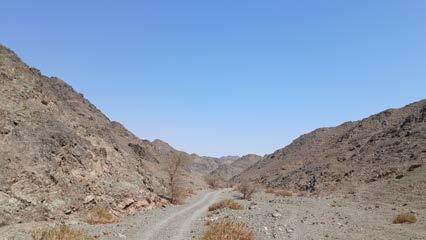
This site qualifies as a KBA of local-Red Sea zone significance that meets several thresholds for the identification of a KBA, namely: Criterion A1 (six VU species), B1 (14 geographically restricted species), B2 (six endemic species), C (considerable area classified as Last of the Wild).
Table 16 Biodiversity elements triggering KBA criteria. Keywords: L= Local-Red Sea zone level, R= Regional level. See Ferreira et al. ( 2024 ) for more details.
Vascular plants Capparis cartilaginea Yes
Capparis spinosa Yes
Chrozophora oblongifolia Yes Cleome droserifolia VU Cleome paradoxa Yes
Convolvulus glomeratus Yes
Euphorbia arabica Yes
Hyparrhenia hirta Yes
Morettia parviflora Yes
Ricinus communis Yes
Teucrium leucocladum Yes
Vachellia gerrardi Yes
Zaleya pentandra Yes
Cheesman’s Gerbil
Gerbillus sp. nov. 1
Geoffroy’s Myotis VU
Egyptian Slit-faced Bat VU Birds Bar-tailed Lark Yes
Pharaoh Eagle-owl VU
Short-toed Snake-eagle VU
African Collared-dove Yes
European Turtle-dove Yes
Desert Tawny Owl VU Scorpions Khaybari Striped Scorpion Yes
Eclipse Deathstalker Yes
Arabian Burrowing Scorpion Yes
Crit. C Last of the Wild (km2): 229
Crit. B4, D2, D3 Wetlands (km2): 0.01 (4,070 m2). The site includes a permanent 5.16 cm dam that accumulates freshwater for
200 m inside a mountain canyon. Despite the small size, it is of high relevance to the local-Red Sea zone fauna.

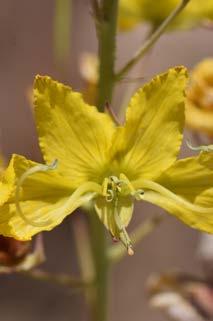



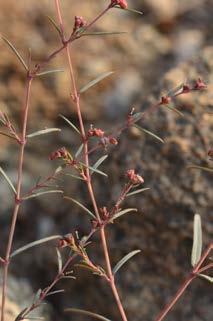

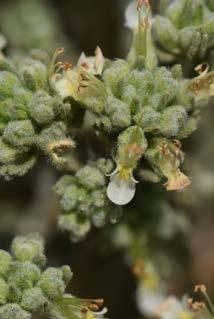

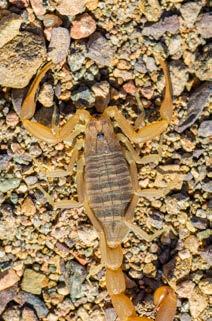


The recommendations aim to strengthen Red Sea environmental stewardship by embedding KBAs into all aspects of development and conservation. This approach will not only align with international biodiversity goals but also enhance RSG reputation as a leader in sustainable development:
1. Mainstream KBAs into RSG/Red Sea zone Master Plans:
• Adopt the KBA data as a primary layer for spatial planning and development decisions.
• Mandate the inclusion of KBA considerations in Environmental & Social Impact Assessments (ESIAs) for all projects.
2. Designate Conservation Areas Based on KBAs:
• Prioritize KBAs for establishing conservation and protected areas under the IUCN criteria.
• Allocate funding and resources to strengthen protection measures for these areas.
3. Incorporate KBAs into Tourism Planning:
• Develop ecotourism strategies that emphasize KBAs as unique selling points for RSG/Red Sea zone.
• Introduce interpretive programs and infrastructure (e.g., guided trails, bird hides) that enhance visitor experience while preserving biodiversity.
4. Align Infrastructure Development with KBA Conservation:
• Require all infrastructure projects to adopt mitigation measures for impacts on KBAs.
• Deliver a 30% net conservation gain policy for biodiversity, particularly focusing on critical habitats like mangroves and wetlands.
5. Collaborate with Neighboring GigaProjects:
• Establish an interproject working group to coordinate conservation
efforts across The Red Sea and AMAALA destinations, and other gigaprojects.
Develop a shared KBA management framework that ensures consistent protection standards.
6. Utilize KBAs as Tools for Future Development:
Position KBAs as baseline indicators for achieving biodiversity net gain targets by 2030 Link KBAs to broader climate adaptation and resilience strategies, leveraging their ecosystem services.
7. Address Knowledge Gaps: Invest in targeted research to address the data deficiencies highlighted in the report.
Partner with academic institutions to continuously update the KBA database with new findings.
8. Stakeholder Engagement and Community Involvement: Involve local-Red Sea zone communities in KBA conservation through education, employment in conservation roles, and shared economic benefits.
Create a communication strategy to raise awareness of the importance of KBAs among internal and external stakeholders.
9. Policy and Monitoring Framework: Develop policy guidelines specific to KBA protection and management within RSG governance. Establish a monitoring system to evaluate the effectiveness of conservation actions over time.
10. Innovative Conservation Solutions: Explore the use of remote sensing and GIS technologies for dynamic KBA monitoring. Pilot habitat restoration projects in degraded KBAs to showcase RSG commitment to environmental leadership.
Al Obaid A., Shuraim F, Al Boug A, Al Jbour S, Neyaz F, Aloufi AH, Amr Z (2023). Diversity and conservation of bats in Saudi Arabia. Diversity 15, 700.
Babbington J, Boland C, Kirwan GM, Alsuhaibany A, Shirihai H, Schweizer M (2019). Confirmation of Common Acrocephalus scirpaceus avicenniae (Aves: Acrocephalidae) from mangroves on the Red Sea coast near Jazan, southwest Saudi Arabia. Zoology in the Middle East 65, 201–207.
Calabrese L (2022). Bird phenology abundance and distribution at TRSP. Internal Report.
Calabrese L, Riordan JA, Lloyd IA, Foster AD, Collier TE, Chambon JA, Aljohani YW, Alhamdi EA, Beaumont PR, Williams ID, Al-Attas O (2024). A sea of birds: first bird population assessments in the Saudi Arabian Red Sea. Frontiers in Marine Science 11, 1379601.
Ferreira D, Panisi M, Alzahrani AM, Bilancioni M, Campos JC, Coelho A, Gonçalves DV, Khafsha AHM, Khalatbari L, Lakušić M, Lakušić V, Licata F, Liz AV, Oliveira R, Rebelo H, Roumelioti GM, Santos B, Simone Y, Sousa J, Brito JC (2024). Spatial Habitat Assessment for Biodiversity Conservation. Deliverable 3: Evaluating Key Terrestrial Biodiversity Areas. BIOPOLIS/CIBIOInBIO/ BIODESERTS, University of Porto. Red Sea Global. 244 pages + xxiii annexes. IUCN (2016). A Global Standard for the Identification of Key Biodiversity
Areas, Version 1.0. First edition. Gland, Switzerland: IUCN.
KBA Standards and Appeals Committee (2022). Guidelines for using A Global Standard for the Identification of Key Biodiversity Areas. Version 1.2. Prepared by the KBA Standards and Appeals Committee of the IUCN Species Survival Commission and IUCN World Commission on Protected Areas. Gland, Switzerland: IUCN.
Key Biodiversity Areas Partnership (2025). Key Biodiversity Areas factsheet: Al Wajh Bank. Extracted from the World Database of Key Biodiversity Areas. Developed by the Key Biodiversity Areas Partnership: BirdLife International, IUCN, American Bird Conservancy, Amphibian Survival Alliance, Conservation International, Critical Ecosystem Partnership Fund, Global Environment Facility, Re:wild, NatureServe, Rainforest Trust, Royal Society for the Protection of Birds, World Wildlife Fund and Wildlife Conservation Society. Downloaded from https://keybiodiversityareas.org/ on Mar 13, 2025.
Mallon DP, HiltonTaylor C, Amori G, Baldwin R, Bradshaw PL, Budd K. (2023). The conservation status and distribution of the mammals of the Arabian Peninsula. Gland, Switzerland: IUCN and Sharjah, United Arab Emirates: Environment and Protected Areas Authority
• Biodiversity: The variety of life in a particular habitat or ecosystem, including the diversity of species, genetic variation, and ecosystems.
• Key Biodiversity Area (KBA): Specific sites that contribute significantly to the global or regional persistence of biodiversity, identified using IUCN criteria.
• IUCN (International Union for Conservation of Nature): A global organization providing standards and guidelines for conservation efforts, including the identification of KBAs.
• Endemic Species: Species that are native to a particular region and found nowhere else.
• Geographically Restricted Species: Species that have a limited geographic range.
• Demographic Aggregations: Groups of individuals of a species that gather in large numbers for reproduction, feeding, migration, or other ecological purposes.
• Ecological Integrity: The state of an ecosystem where its natural processes, biodiversity, and functioning are intact and minimally affected by human activities.
• Threatened Species: Species classified as Critically Endangered (CR), Endangered (EN), or Vulnerable (VU) under the IUCN Red List due to risks of extinction.
• Habitat: The natural environment where a species lives, including all biotic and abiotic factors.
• Ecosystem Services: Benefits provided by ecosystems to humans, including clean air, water, food, and climate regulation.
• Sustainable Development: Development that meets the needs of the present without compromising the
ability of future generations to meet their own needs, balancing economic growth, environmental protection, and social equity.
Biodiversity Net Gain (BNG): A conservation approach ensuring that development projects leave biodiversity in a better state than before.
Restoration Ecology: The scientific study and practice of restoring degraded ecosystems to their original conditions.
Ecosystem Type: A classification of ecosystems based on dominant vegetation, species composition, and ecological processes.
Wetlands: Ecosystems saturated with water, such as swamps, marshes, and bogs, that support specific plants and wildlife.
Mangroves: Coastal ecosystems made up of salttolerant trees and shrubs that provide critical habitat and coastal protection.
Regenerative Tourism: Tourism that goes beyond sustainability by actively improving the environment, communities, and economies of the destinations it impacts.
Vision 2030 : Saudi Arabia›s strategic framework for reducing its dependency on oil and diversifying its economy while improving public sector services and sustainability.
• Spatial Habitat Assessment: The evaluation of habitats based on spatial data to identify conservation priorities and management strategies.
• Ecotourism: Tourism that is focused on sustainable travel to natural areas, promoting conservation, and benefiting local-Red Sea zone communities.
• Environmental Impact Assessment (EIA): A process used to evaluate the environmental consequences of proposed developments before they are carried out.
• Anthropogenic Impacts: Environmental changes caused by human activities, such as deforestation, pollution, and urbanization.
• Conservation Area: A designated area that is managed to protect and preserve biodiversity, natural landscapes, and cultural heritage.
• Protected Area: A clearly defined geographical space recognized and managed for longterm conservation of nature, including ecosystem services and cultural values.
• Invasive Species: Nonnative species that spread rapidly in a new environment, often causing ecological or economic harm.
• Ecological Footprint: A measure of the impact of human activities on the environment in terms of the amount of natural resources consumed and waste generated.
• Climate Adaptation: Strategies to manage the impacts of climate change on ecosystems and human systems.
• GIS (Geographic Information System): A system for capturing, storing, analyzing, and managing spatial and geographic data.
Last of the Wild: Areas that are minimally impacted by human activities, maintaining ecological integrity and supporting biodiversity.
Conservation Priority: Species, habitats, or regions identified as needing urgent protection or management due to their ecological importance or risk of degradation.
Natural Capital: The world’s natural resources and ecosystems, which provide valuable goods and services to humans.
Threat Mitigation: Actions taken to reduce or eliminate the adverse effects of threats on biodiversity or ecosystems.
Stakeholder Engagement: Involvement of various parties, including local-Red Sea zone communities, governments, and organizations, in decisionmaking processes for conservation and development.
Biodiversity Hotspot: A biogeographic region with significant levels of biodiversity that is under threat from human activities.
Adaptive Management: A systematic, iterative approach to managing natural resources that adjusts practices based on monitoring and new information.

By DR. OMAR AL-ATTAS
Head of Red Sea Zone
This report represents a significant milestone in our unwavering commitment to protecting and enhancing the terrestrial biodiversity of the Red Sea zone. By establishing a robust ecological baseline, it provides the scientific foundation necessary to guide our longterm conservation and regenerative efforts.
Through rigorous fieldwork and comprehensive scientific analysis, we have identified 11 Key Biodiversity Areas (KBAs)—critical habitats that support threatened, endemic, and geographically restricted species, in alignment with IUCN criteria. These findings reinforce the ecological importance of the Red Sea’s landscapes, underscoring their extraordinary value and the urgent need for sustained regeneration.
Biodiversity conservation is an evolving journey—one of continuous learning, monitoring, and adaptation. This initiative sets a benchmark, enabling us to measure progress, refine strategies, and achieve our ambitious 30% Net Conservation Gain by 2040. The insights gained will directly shape our environmental management frameworks, ecological restoration programs, and regenerative tourism strategies, ensuring that our projects not only mitigate impact but actively restore and enhance natural ecosystems.
At Red Sea Global, we are redefining responsible development—demonstrating that luxury tourism and environmental stewardship can thrive together. By leveraging science, innovation, and collaboration, we are creating a destination where every visitor becomes a partner in conservation. Transparency and accountability remain at the heart of our mission. We invite scientists, conservationists, local-Red Sea zone communities, and global partners to join us in pioneering a new model for sustainable development—one that safeguards the Red Sea’s unparalleled biodiversity for generations to come.

This report represents a significant milestone in our unwavering commitment to protecting and enhancing the terrestrial biodiversity of the Red Sea zone. By establishing a robust ecological baseline, it provides the scientific foundation necessary to guide our longterm conservation and regenerative efforts.
Through rigorous fieldwork and comprehensive scientific analysis, we have identified 11 Key Biodiversity Areas (KBAs)—critical habitats that support threatened, endemic, and geographically restricted species, in alignment with IUCN criteria. These findings reinforce the ecological importance of the Red Sea’s landscapes, underscoring their extraordinary value and the urgent need for sustained regeneration.
Biodiversity conservation is an evolving journey—one of continuous learning, monitoring, and adaptation. This initiative sets a benchmark, enabling us to measure progress, refine strategies, and achieve our ambitious 30% Net Conservation Gain by 2040. The insights gained will directly shape our environmental management frameworks, ecological restoration programs, and regenerative tourism strategies, ensuring that our projects not only mitigate impact but actively restore and enhance natural ecosystems.
At Red Sea Global, we are redefining responsible development—demonstrating that luxury tourism and environmental stewardship can thrive together. By leveraging science, innovation, and collaboration, we are creating a destination where every visitor becomes a partner in conservation. Transparency and accountability remain at the heart of our mission. We invite scientists, conservationists, local-Red Sea zone communities, and global partners to join us in pioneering a new model for sustainable development—one that safeguards the Red Sea’s unparalleled biodiversity for generations to come.